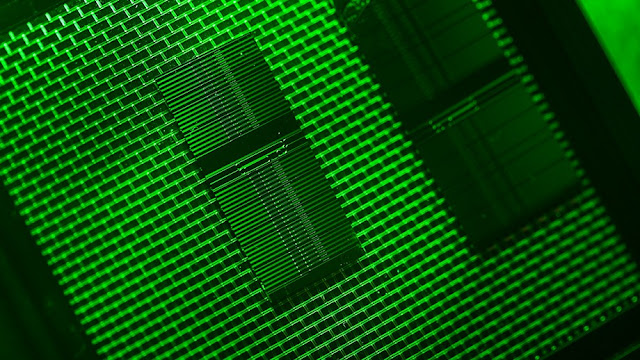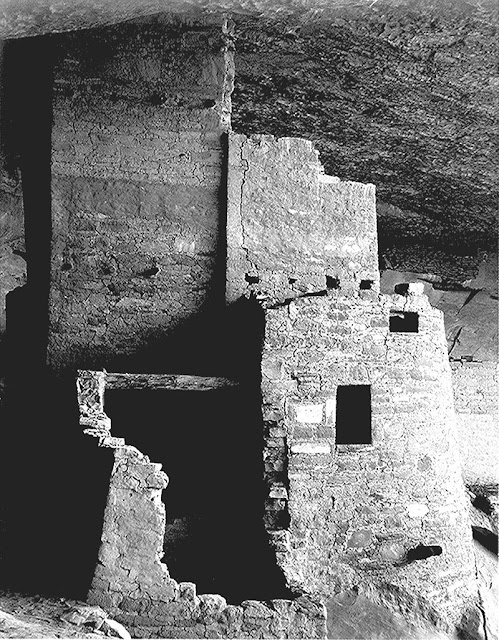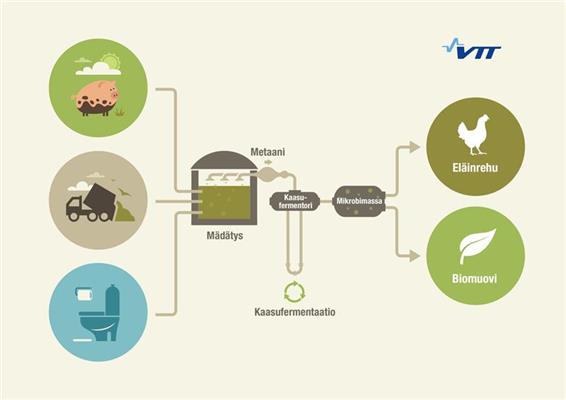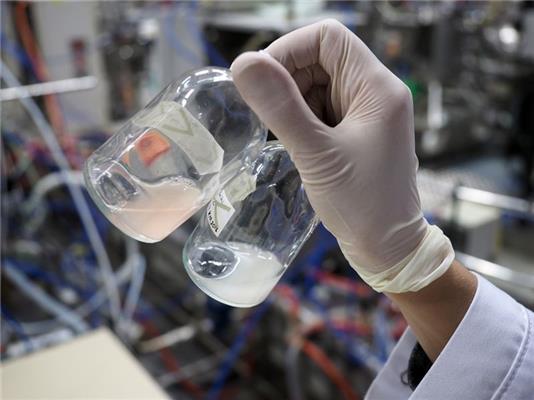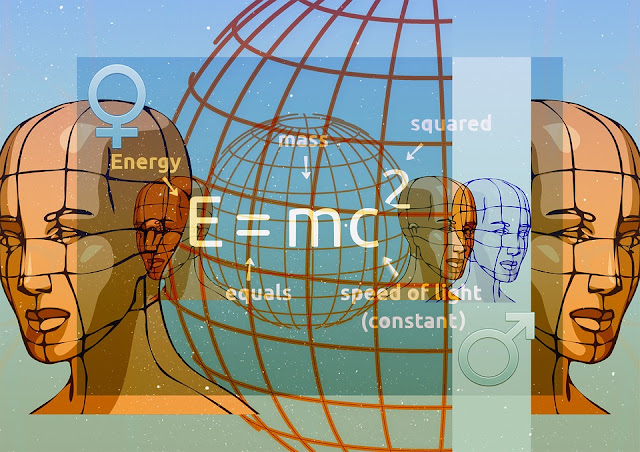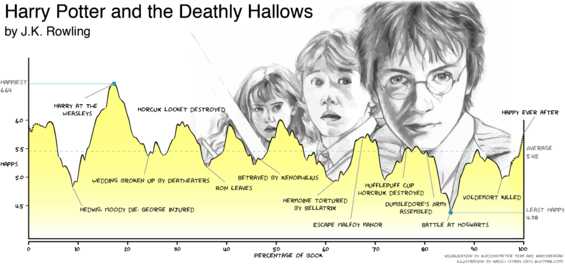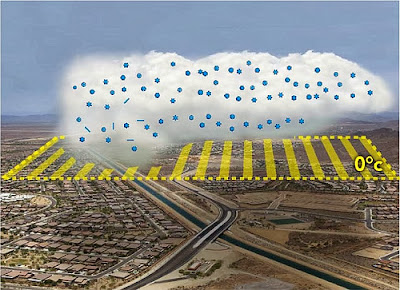December 20th, 2016
By Don Irvine.
An international research team at the Department of Historical Studies, University of Gothenburg, is exploring the remains of an ancient city in central Greece. The results can change the view of an area that traditionally has been considered a backwater of the ancient world.
Archaeologists from the University of Gothenburg have begun exploring a previously unknown ancient city at a village called Vlochós, five hours north of Athens. The archaeological remains are scattered on and around the Strongilovoúni hill on the great Thessalian plains and can be dated to several historical periods.
The city’s acropolis is barely visible during a cloudy day on the Thessalian plains.
Credit: SIA/EFAK/YPPOA
‘What used to be considered remains of some irrelevant settlement on a hill can now be upgraded to remains of a city of higher significance than previously thought, and this after only one season,’ says Robin Rönnlund, PhD student in Classical Archaeology and Ancient History at the University of Gothenburg and leader of the fieldwork.
‘A colleague and I came across the site in connection with another project last year, and we realised the great potential right away. The fact that nobody has never explored the hill before is a mystery.’
Fortress walls, towers and city gates are clearly visible from the air.
Credit: SIA/EFAK/YPPOA
In collaboration with the Swedish Institute at Athens and the local archaeological service in Karditsa, the Vlochós Archaeological Project (VLAP) was started with an aim to explore the remains. The project’s research team completed the first field season during two weeks in September 2016.
Rönnlund says that the hill is hiding many secrets. Remains of towers, walls and city gates can be found on the summit and slopes, but hardly anything is visible on the ground below. The ambition is to avoid excavation and instead use methods such as ground-penetrating radar, which will enable the team to leave the site in the same shape as it was in when they arrived. The success of this approach is evident from the results of the first field season:
Fragment of red-figure pottery from the late 6th century BC, probably by Attic painter Paseas
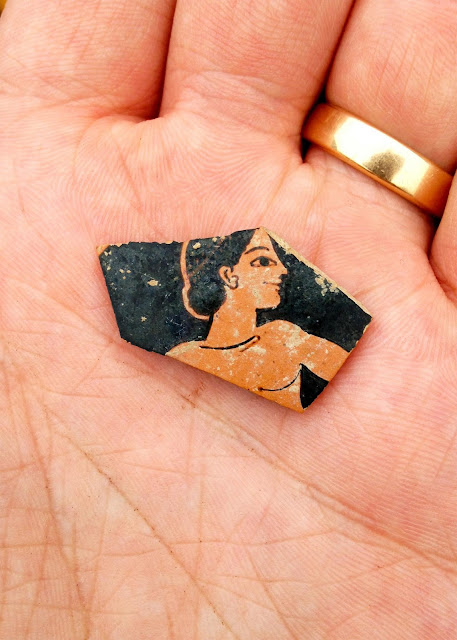
Credit: SIA/EFAK/YPPOA
‘We found a town square and a street grid that indicate that we are dealing with quite a large city. The area inside the city wall measures over 40 hectares. We also found ancient pottery and coins that can help to date the city. Our oldest finds are from around 500 BC, but the city seems to have flourished mainly from the fourth to the third century BC before it was abandoned for some reason, maybe in connection with the Roman conquest of the area.
Rönnlund believes that the Swedish-Greek project can provide important clues as to what happened during this violent period in Greek history.
‘Very little is known about ancient cities in the region, and many researchers have previously believed that western Thessaly was somewhat of a backwater during Antiquity. Our project therefore fills an important gap in the knowledge about the area and shows that a lot remains to be discovered in the Greek soil.’
The Vlochós Archaeological Project (VLAP):
VLAP is a collaboration between the Ephorate of Antiquities of Karditsa and the Swedish Institute at Athens. In 2016-2017, a team of researchers from the University of Gothenburg and University of Bournemouth is exploring the remains of a city in Vlochós as part of the project. Read more at vlap.se
Comments Off on Unknown City Discovered In Greece By Swedish And Greek Archaeologist
December 14th, 2016
The Daily Journalist.
The largest estimate of continuous oil that USGS has ever assessed in the United States is worth hundreds of billions of dollars.
The Wolfcamp shale in the Midland Basin portion of Texas’ Permian Basin province contains an estimated mean of 20 billion barrels of oil, 16 trillion cubic feet of associated natural gas, and 1.6 billion barrels of natural gas liquids, according to an assessment by the U.S. Geological Survey. This estimate is for continuous (unconventional) oil, and consists of undiscovered, technically recoverable resources.
The estimate of continuous oil in the Midland Basin Wolfcamp shale assessment is nearly three times larger than that of the 2013 USGS Bakken-Three Forks resource assessment, making this the largest estimated continuous oil accumulation that USGS has assessed in the United States to date.
“The fact that this is the largest assessment of continuous oil we have ever done just goes to show that, even in areas that have produced billions of barrels of oil, there is still the potential to find billions more,” said Walter Guidroz, program coordinator for the USGS Energy Resources Program. “Changes in technology and industry practices can have significant effects on what resources are technically recoverable, and that’s why we continue to perform resource assessments throughout the United States and the world.”
Credit: U.S. Geological Survey.
Although the USGS has assessed oil and gas resources in the Permian Basin province, this is the first assessment of continuous resources in the Wolfcamp shale in the Midland Basin portion of the Permian.
Since the 1980s, the Wolfcamp shale in the Midland Basin has been part of the “Wolfberry” play that encompasses Mississippian, Pennsylvanian, and Lower Permian reservoirs. Oil has been produced using traditional vertical well technology.
However, more recently, oil and gas companies have been using horizontal drilling and hydraulic fracturing, and more than 3,000 horizontal wells have been drilled and completed in the Midland Basin Wolfcamp section.
The Wolfcamp shale is also present in the Delaware Basin portion of the Permian Basin province, but was not included in this assessment. The Permian Basin province includes a series of basins and other geologic formations in West Texas and southern New Mexico. It is one of the most productive areas for oil and gas in the entire United States.
Continuous oil and gas is dispersed throughout a geologic formation rather than existing as discrete, localized occurrences, such as those in conventional accumulations. Because of that, continuous resources commonly require special technical drilling and recovery methods, such as hydraulic fracturing.
Undiscovered resources are those that are estimated to exist based on geologic knowledge and theory, while technically recoverable resources are those that can be produced using currently available technology and industry practices. Whether or not it is profitable to produce these resources has not been evaluated.
USGS is the only provider of publicly available estimates of undiscovered technically recoverable oil and gas resources of onshore lands and offshore state waters. The USGS Wolfcamp shale assessment was undertaken as part of a nationwide project assessing domestic petroleum basins using standardized methodology and protocol.
Comments Off on USGS Estimates 20 Billion Barrels Of Oil In Texas
December 9th, 2016
If society continues to pump greenhouse gases into the atmosphere at the current rate, Americans later this century will have to endure, on average, about 15 daily maximum temperature records for every time that the mercury notches a record low, new research indicates.
That ratio of record highs to record lows could also turn out to be much higher if the pace of emissions increases and produces even more warming, according to the study led by scientists at the National Center for Atmospheric Research (NCAR).
Over the last decade, in contrast, the ratio of record high temperatures to record lows has averaged about two to one.
The United States has experienced unusual warmth lately, as indicated by this July 22, 2016, weather map showing much of the country facing highs in the 90s and 100s and lows in the 70s. New research indicates that more record high temperatures may be in store.
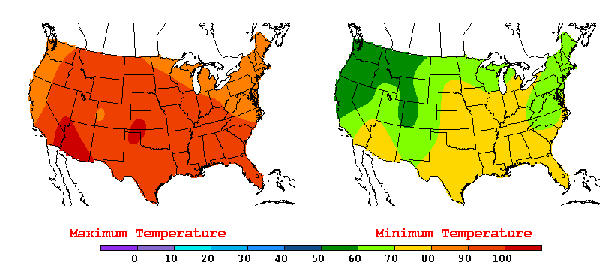
Credit: Weather map by the National Oceanic and Atmospheric Administration’s Weather Prediction Center.
“More and more frequently, climate change will affect Americans with record-setting heat,” said NCAR senior scientist Gerald Meehl, lead author of the new paper. “An increase in average temperatures of a few degrees may not seem like much, but it correlates with a noticeable increase in days that are hotter than any in the record, and nights that will remain warmer than we’ve ever experienced in the past.”
The 15-to-1 ratio of record highs to lows is based on temperatures across the continental United States increasing by slightly more than 3 degrees Celsius (5.4 degrees Fahrenheit) above recent years, which is about the amount of warming expected to occur with the current pace of greenhouse gas emissions.
The new research appears this week in the “Proceedings of the National Academy of Sciences.” It was funded by the Department of Energy (DOE) and the National Science Foundation (NSF), which is NCAR’s sponsor. The study was coauthored by NCAR scientist Claudia Tebaldi and by Dennis Adams-Smith, a scientist previously at Climate Central and now at the National Oceanic and Atmospheric Administration’s Geophysical Fluid Dynamics Laboratory.
HOTTER DAYS
In a 2009 study, Meehl and colleagues found that the ratio of record daily high temperatures to record daily low temperatures has steadily increased since the 1970s as average temperatures over the United States have warmed. Computer models at that time indicated that the ratio could continue to increase during this century, although the research team looked into just one scenario of future emissions. The scientists also found that the models were overstating the ratio of record highs to record lows in recent years, compared to observations.By digging further into the issue and analyzing why the models differed from observations, Meehl and his co-authors have now produced a better calibrated projection of future record-breaking daily highs across the U.S. They based their projections on the average temperature increase over the continental United States, rather than on a particular scenario of future emissions.
By about 2065, for example, U.S. temperatures will rise by an average of slightly more than 3 degrees C (5.4 degrees F) if society maintains a “business as usual” increase in the emission of greenhouse gases. Under such a scenario, the ratio of record daily high temperatures to record daily lows will likely be about 15 to 1, although it could range anywhere from 7 to 1 up to 22 to 1, the study found.
If temperatures increase even more this century, the ratio of record highs to record lows will jump substantially. For example, if temperatures climb more than 4 degrees C (7.2 degrees F), Americans could experience about 38 record highs for every record low. Such an outcome could occur if society does not make any efforts to mitigate the production of greenhouse gases.
“Every degree of warming makes a substantial amount of difference, with the ratio of record highs to record lows becoming much greater,” Meehl said. “Even with much warmer temperatures on average, we will still have winter and we will still get record cold temperatures, but the numbers of those will be really small compared to record high maximums.”
If temperatures were not warming, Meehl said, the ratio of record highs to record lows would average out to about one to one.
Instead, record high temperatures have already become a common occurrence in much of the country. The ratio of record highs to lows has averaged about 2 to 1 over the first decade of the 21st century, but there is considerable year-to-year variation. The ratio was about 5 to 1 in 2012, dropping to about 1 to 1 in 2013 and 2014, then almost 3 to 1 in 2015. The unusual warmth of 2016, resulting from both climate change and natural patterns such as El Niño, has led to 24,519 record daily maximums vs. 3,970 record daily minimums—a ratio of about 6 to 1.
PRECIPITATION AND THE WARM 1930S
A key part of the study involved pinpointing why the models in the 2009 study were simulating somewhat more daily record high maximum temperatures compared with recent observations, while there was good agreement between the models and the observed decreases in record low minimums. The authors focused on two sets of simulations conducted on the NCAR-based Community Climate System Model (version 4), which is funded by DOE and NSF and developed by climate scientists across the country.Their analysis uncovered two reasons for the disparity between the computer models and observations.
First, the models tended to underestimate precipitation. Because the air is cooled by precipitation and resulting evapotranspiration — the release of moisture from the land and plants back to the atmosphere — the tendency of the computer models to create an overly dry environment led to more record high temperatures.
Second, the original study in 2009 only went back to the 1950s. For the new study, the research team also analyzed temperatures in the 1930s and 1940s, which is as far back as accurate recordkeeping will allow. Because the Dust Bowl days of the 1930s were unusually warm, with many record-setting high temperatures, the scientists found that it was more difficult in subsequent years to break those records, even as temperatures warmed. However, even taking the warm 1930s into account, both the model-simulated and observed ratio of record highs to record lows have been increasing.
“The steady increase in the record ratio is an immediate and stark reminder of how our temperatures have been shifting and continue to do so, reaching unprecedented highs and fewer record lows,” said Tebaldi. “These changes pose adaptation challenges to both human and natural systems. Only a substantial mitigation of greenhouse gas emissions may stop this increase, or at least slow down its pace.”
Comments Off on Days Of Record-Breaking Heat Ahead
December 9th, 2016
Scientists have developed a new optical chip for a telescope that enables astronomers to have a clear view of alien planets that may support life.
Seeing a planet outside the solar system which is close to its host sun, similar to Earth, is very difficult with today’s standard astronomical instruments due to the brightness of the sun.
Associate Professor Steve Madden from The Australian National University (ANU) said the new chip removes light from the host sun, allowing astronomers for the first time to take a clear image of the planet.
New telescope chip
Credit: Stuart Hay, ANU
“The ultimate aim of our work with astronomers is to be able to find a planet like Earth that could support life,” said Dr Madden from the ANU Research School of Physics and Engineering.
“To do this we need to understand how and where planets form inside dust clouds, and then use this experience to search for planets with an atmosphere containing ozone, which is a strong indicator of life.”
Physicists and astronomers at ANU worked on the optical chip with researchers at the University of Sydney and the Australian Astronomical Observatory.
Dr Madden said the optical chip worked in a similar way to noise cancelling headphones.
“This chip is an interferometer that adds equal but opposite light waves from a host sun which cancels out the light from the sun, allowing the much weaker planet light to be seen,” he said.
PhD student Harry-Dean Kenchington Goldsmith, who built the chip at the ANU Laser Physics Centre, said the technology works like thermal imaging that fire fighters rely on to see through smoke.
“The chip uses the heat emitted from the planet to peer through dust clouds and see planets forming. Ultimately the same technology will allow us to detect ozone on alien planets that could support life,” said Mr Kenchington Goldsmith from the ANU Research School of Physics and Engineering.
The Milky Way
Credit: Roanish, Flickr
The innovation builds on over 10 years of research on specialised optical materials and devices that has been supported through CUDOS, a centre of excellence funded by the Australian Research Council.
The research is being presented at the Australian Institute of Physics Congress in Brisbane this week.
Comments Off on Chip Will Offer Clear View Of Alien Planets
December 7th, 2016
The recent legalization of recreational marijuana (cannabis) use in California, Colorado, and Washington reflect the sweeping changes in the attitudes and perceptions towards marijuana use in the United States. Eight states have voted in favor of legal recreational marijuana and 26 states in total allow medicinal marijuana.
This trend has also continued in Europe as more countries have been becoming pro-marijuana. Companies like Zamnesia are extremely useful to consumers as they offer top strains like OG Kush and education on the specific strains.
There is a common misperception that widespread marijuana use is limited to younger generations. However, the Baby Boomer generation has reported higher rates of substance use than any preceding generation.
“Given the unprecedented aging of the U.S. population, we are facing a never before seen cohort of older adults who use recreational drugs,” says Benjamin Han, MD, MPH, a geriatrician and health services researcher at the Center for Drug Use and HIV Research (CDUHR) and in the Division of Geriatric Medicine and Palliative Care at NYU Langone Medical Center (NYULMC).’

“With the increased availability of legalized marijuana, there is an urgent need to understand the prevalence of its use and also its effects among older generations,” continued Dr. Han. “The paucity of knowledge in this area constrains the care for a changing demographic of older adults with higher rates of substance use.”
To address this, Dr. Han and his team led a study, “Demographic Trends among Older Cannabis Users in the United States, 2006-2013.” Published in Addiction, the study sought to determine the trends in the prevalence and patterns of cannabis use, attitudes towards cannabis use, and determine correlates of use among adults over the age of 50.
The researchers evaluated responses from 47,140 adults aged 50 and older in the United States through a secondary analysis of the National Survey on Drug Use and Health (NSDUH) from 2006 to 2013. The NSDUH provides national data on the use of tobacco, alcohol, illicit drugs and mental health in the United States.
The authors found a 71% increase in marijuana use among adults aged 50 and older between 2006 and 2013. Adults ages 65 and older had a significantly lower prevalence of marijuana use compared to those ages 50-64, but prevalence of use increased two and a half times over eight years. Overall, prevalence was higher among men than women through all years.
“We found only five percent of these older adults felt using marijuana once or twice a week was a great risk to their health” said Joseph J. Palamar, PhD, MPH, a CDUHR affiliated researcher and an assistant professor of Population Health at NYULMC.
“I thought the perception of low risk was fascinating because, typically, we think of older generations as drug-adverse, and perceiving most drugs to be risky,” said Dr. Palamar. “But apparently very few Baby Boomers consider marijuana use risky. But after all, this was the generation who was there, in the late 1960s, when the counterculture revolution exploded marijuana into mainstream popularity.”
]
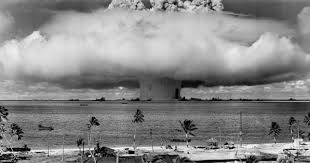
Credit: Wikimedia Commons
The researchers note that the majority of self-reported marijuana users indicated they first started using before the age of 18. This means that most of the current users either continued use or have begun using again more recently. Research is needed to determine whether this is related to changes in local, state, and national acceptance.“Personally, I don’t think we need to be very alarmed about most older people who are using marijuana,” notes Dr. Palamar, “as our results suggest that only 4% started use after age 35. It is probable that most older users are at least somewhat experienced and are hopefully at reasonably low risk of harming themselves or others after use.”
The results, however, give the researchers reason to believe the population may be at a particularly high risk for adverse health outcomes, as the concurrent use of multiple substances (marijuana, prescribed prescription drug, and even self-prescribed illicit drugs) all used in combination may make older adults further vulnerable to poor physical and mental health outcomes and certainly can impact their care.
Dr. Palamar notes that as a public health researcher, “for years we’ve been worried about the potential effects of marijuana on the developing brains of teens, but now we may need a bit more focus on their grandparents, who are increasingly more likely to be current users.”
“Older people may use marijuana for a variety of reasons—including medical reasons—however we need to make sure they are not using in a hazardous manner since older adults may be vulnerable to its possible adverse effects. One particular concern for older users is the risk of falls while using marijuana, however this has not yet been studied,” Dr. Han added.
This study underscores the need for further research on marijuana use and its effects in this population. More importantly, the research dispels the myth that older adults do not use recreational drugs. It is the researchers’ hope that their study encourages cannabis use questions to become a part of older adults’ care plan screenings.
Comments Off on “Baby Boomers” On Dope: Recreational Marijuana Use Is On The Rise Among Adults Over 50
December 6th, 2016
Major scientific breakthrough research has discovered new materials offering an alternative to battery power and proven to be between 1,000-10,000 times more powerful than the existing battery alternative – a supercapacitor.
The new technology is believed to have the potential for electric cars to travel to similar distances as petrol cars without the need to stop for lengthy re-charging breaks of between 6-8 hours, and instead re-charge fully in the time it takes to fill a regular car with petrol.
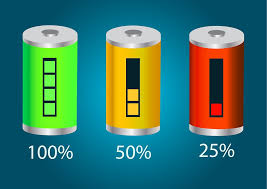
Credit: Pixabay
The scientific findings made by Augmented Optics Ltd and its wholly owned subsidiary Supercapacitor Materials Ltd with the University of Surrey and University of Bristol have produced a safer, faster charging, more efficient and greener alternative to battery power and supercapacitor abilities as we currently know them.
Ground-breaking research from the University of Surrey and Augmented Optics Ltd., in collaboration with the University of Bristol, has developed potentially transformational technology which could revolutionise the capabilities of appliances that have previously relied on battery power to work.
This development by Augmented Optics Ltd., could translate into very high energy density super-capacitors making it possible to recharge your mobile phone, laptop or other mobile devices in just a few seconds.
The technology could have a seismic impact across a number of industries, including transport, aerospace, energy generation, and household applications such as mobile phones, flat screen electronic devices, and biosensors. It could also revolutionise electric cars, allowing the possibility for them to recharge as quickly as it takes for a regular non-electric car to refuel with petrol – a process that currently takes approximately 6-8 hours to recharge. Imagine, instead of an electric car being limited to a drive from London to Brighton, the new technology could allow the electric car to travel from London to Edinburgh without the need to recharge, but when it did recharge for this operation to take just a few minutes to perform.
Supercapacitor buses are already being used in China, but they have a very limited range whereas this technology could allow them to travel a lot further between recharges. Instead of recharging every 2-3 stops this technology could mean they only need to recharge every 20-30 stops and that will only take a few seconds.

Credit: Wikipedia
Elon Musk, of Tesla and SpaceX, has previously stated his belief that supercapacitors are likely to be the technology for future electric air transportation. We believe that the present scientific advance could make that vision a reality.
The technology was adapted from the principles used to make soft contact lenses, which Dr Donald Highgate (of Augmented Optics, and an alumnus of the University of Surrey) developed following his postgraduate studies at Surrey 40 years ago. Supercapacitors, an alternative power source to batteries, store energy using electrodes and electrolytes and both charge and deliver energy quickly, unlike conventional batteries which do so in a much slower, more sustained way. Supercapacitors have the ability to charge and discharge rapidly over very large numbers of cycles. However, because of their poor energy density per kilogramme (approximately just one twentieth of existing battery technology), they have, until now, been unable to compete with conventional battery energy storage in many applications.
Dr Brendan Howlin of the University of Surrey, explained: “There is a global search for new energy storage technology and this new ultra capacity supercapacitor has the potential to open the door to unimaginably exciting developments.”
The ground-breaking research programme was conducted by researchers at the University of Surrey’s Department of Chemistry where the project was initiated by Dr Donald Highgate of Augmented Optics Ltd. The research team was co-led by the Principal Investigators Dr Ian Hamerton and Dr Brendan Howlin. Dr Hamerton continues to collaborate on the project in his new post at the University of Bristol, where the electrochemical testing to trial the research findings was carried out by fellow University of Bristol academic – David Fermin, Professor of Electrochemistry in the School of Chemistry.
Dr Ian Hamerton, Reader in Polymers and Composite Materials from the Department of Aerospace Engineering, University of Bristol said: “While this research has potentially opened the route to very high density supercapacitors, these *polymers have many other possible uses in which tough, flexible conducting materials are desirable, including bioelectronics, sensors, wearable electronics, and advanced optics. We believe that this is an extremely exciting and potentially game changing development.”
*the materials are based on large organic molecules composed of many repeated sub-units and bonded together to form a 3-dimensional network.
Jim Heathcote, Chief Executive of both Augmented Optics Ltd and Supercapacitor Materials Ltd, said: “It is a privilege to work with the teams from the University of Surrey and the University of Bristol. The test results from the new polymers suggest that extremely high energy density supercapacitors could be constructed in the very new future. We are now actively seeking commercial partners in order to supply our polymers and offer assistance to build these ultra high energy density storage devices.”
Comments Off on Batteries Many Times More Powerful
December 6th, 2016
Two markers of regional exchange in the Eastern Mediterranean during the first millennium BCE are the White Painted and Bichrome Wares from Cyprus’s Cypro-Geometric and Cypro-Archaic periods
Cypriot-style pottery may have been locally produced as well as imported and traded in Turkey during the Iron Age, according to a study published November 30, 2016 in the open-access journal PLOS ONE by Steven Karacic from Florida State University, USA, and James Osborne of the University of Chicago, USA.
White Painted and Bichrome Wares are Cypriot-style ceramics produced during the Iron Age that may provide clues about trade in the Eastern Mediterranean at that time. Although these ceramics are often assumed to be imports from Cyprus, excavations in southern Turkey have suggested that some pottery was produced locally, challenging previous assumptions about trade in the Eastern Mediterranean.
Cypro-Geometric III and Cypro-Archaic I (ca. 850-600 BCE) pottery from Tell Tayinat, ancient Kunulua. (1-3) White Painted Ware vertical-sided bowls; (4-7) White Painted Ware barrel jugs; (8-10) Bichrome Ware vertical-sided bowls; (11-12) Bichrome Ware barrel jugs; (13) Bichrome Ware juglet.

Credit: Karacic et al (2016)
The authors of the present study analyzed White Painted and Bichrome Wares recovered from three sites in the Hatay region of Turkey: Tell Tayinat, Çatal Höyük, and Tell Judaidah, using techniques which bombarded the pottery with x-rays and neutrons, providing insight into the chemical elements they contained. Imported and local versions of this pottery had different elemental compositions, which helped the authors determine where this pottery was produced.
When compared with existing datasets, the researchers found that Çatal Höyük and Tell Judaidah may only have had access to pottery imported from Cyprus whereas Tell Tayinat may have made Cypriot-style pottery locally as well as importing it.
Eastern Mediterranean Economic Exchange during the Iron Age: Portable X-Ray Fluorescence and Neutron Activation Analysis of Cypriot-Style Pottery in the Amuq Valley, Turkey.
Credit: Steven Karacic James F. Osborne’
The authors suggest that feasting practices amongst the affluent in Tell Tayinat may have driven demand for Cypriot-style pottery, resulting in either local potters producing this pottery or Cypriot potters settling in the vicinity.
Usually, pottery styles are expected to become increasingly rare the further away they are found from their origin of production, so these findings suggest a complex pattern of exchange in the Eastern Mediterranean during the Iron Age.
“We were surprised to find that locally produced Cypriot-style pottery was consumed at Tell Tayinat but not the other sites included in our study,” says Karacic. “These results indicate complex social and economic interactions between the Amuq and Cyprus that we are only just beginning to understand for the Iron Age.”
Comments Off on Iron Age-Ceramics Suggest Complex Pattern Of Eastern Mediterranean Trade
November 27th, 2016
The Daily Journalist.
While the popular notion of the American Thanksgiving is less than 400 years old, the turkey has been part of American lives for more than 2,000 years. But for much of that time, the bird was more revered than eaten.
Washington State University archaeologists over the years have repeatedly seen evidence, from bones to blankets to DNA extracted from ancient poop, suggesting that the Pueblo people of the Southwest bred turkeys as far back as 200 B.C.
“Turkeys were an important bird symbolically and in practical ways as a source of feathers that kept people warm in the winter,” said Bill Lipe, a WSU professor emeritus of anthropology with decades of experience in the area. “And they were also important as a food source, probably primarily at periodic feasts and ritual gatherings.”
Part of Chaco Canyon’s Pueblo Bonito built by the Pueblo people
Credit: National Park Service
Ritual and practical importance
In what is called the Basketmaker II era, which ran from 400 B.C. to 500 A.D., ancient Pueblo people shifted from making blankets of rabbit fur to using turkey feathers. One blanket could require 12,000 feathers, which could be taken as the birds molted.
The blankets helped ward off the high-altitude chill of Mesa Verde, but the turkeys also “must have had some symbolic importance,” said Lipe. “That continues all the way through to the present. Turkey feathers are still ritually quite important among Pueblo people.”
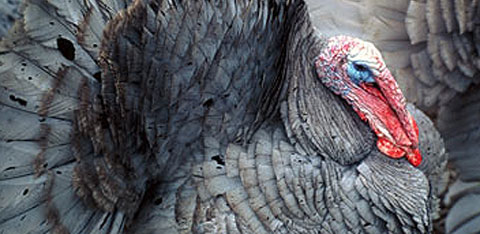
Credit: Washington State University
In the late 1100s, the Pueblo population boomed from what is now Mesa Verde National Park over into nearby southeast Utah. Computer models developed at WSU by anthropologists Tim Kohler and Kyle Bocinsky suggest that deer, a major protein source, were getting hunted out and replaced by turkeys as a source of meat.
Thanksgiving then, too
That’s reflected in the decline of deer bones found in ancient middens, or waste sites, and the rise in the number of turkey bones, said Lipe.
“At some of the larger sites it looks as if they were getting the majority of their meat supply from turkeys, with deer and rabbits being less important,” he said.
Per-capita consumption appears to have averaged around three-fourths to one and a half turkeys per year. That’s not much, but in a village of 500 people, it adds up.
“This was an important bird as a food source as well as symbolically important and valuable for making warming blankets throughout this whole period,” Lipe said. “Turkeys were one of the things they had to be thankful for.”
Maize on the menus
The bird was no Butterball. In fact, said Lipe, historical and genetic evidence indicates a different variety – independently domesticated in Mexico – was taken by the Spanish to Europe. It was later brought back to North America, where it became the basis for the present-day turkey raising industry.
Lipe’s research is looking at the cost to Pueblo people of raising turkeys for meat. About three-fourths of the Pueblo diet was maize, a type of corn, and raising a turkey required either diverting a substantial amount of the crop to the bird or growing more. Lipe calculates that raising one turkey per person each year could consume roughly one-fourth of the maize harvest.
Cliff Palace, Mesa Verde National Park
Credit: Ansel Adams
“Converting maize to turkey meat would have added to the risks of farming in a dry-farming area that had highly variable rainfall patterns,” Lipe said. “Of course, in case of a crop failure, the turkey flock could have been reduced, but probably at the risk of increasing the risk of nutritional problems, especially in children.”
Relocation, less reliance on turkeys
Lipe is gathering data that indicates turkey consumption in the Mesa Verde area peaked in the 1200s when the human population was also peaking. Over the following century, the area underwent a massive depopulation, emptying out the elaborate cliff dwellings with which the people are so often identified.
There’s good evidence that many of the people moved to the northern Rio Grande area about 200 miles southeast to escape a variety of stresses: the threat of warfare, recurring drought and new community leadership and organization, Lipe said. It’s possible, he said, that yet another contributing factor was “the costs and risks of raising large flocks of turkeys.”
The people continued to raise turkeys in the Rio Grande area, but archaeological evidence indicates they went back to relying more on deer for meat.
Comments Off on Americans Feasting On Turkey 2,300 Years Ago
November 27th, 2016
VTT has developed a solution for converting even small sources of methane-rich biogas into raw materials for animal feed or bioplastic on farms, landfills and wastewater treatment plants. This emission-reducing solution is based on the ability of methanotrophic bacteria to grow on methane in gas fermentors.
Methane-rich biogas is generated on farms, landfills and wastewater treatment plants in anaerobic digestion of biological material. Until now, the processing of such gas into biomethane has only been viable on large biogas-producing sites; small biogas sources such as farms have remained largely unexploited.
Infographic: VTT’s gas fermentation process
Credit; VTT
The method developed by VTT would reduce emissions, increase the use of biogas and improve protein self-sufficiency.
It is based on the ability of methanotrophic bacteria to grow in aerobic conditions in gas fermentors, using methane as the source for carbon and energy. The process is as follows: The methane gas generated by anaerobic digestion is fed into a gas fermentor. A growth medium containing the methanotrophic bacteria circulates through the pipes of the gas fermentor, creating a single-cell protein biomass with a protein content of around 60%. The cell mass is filtered, pasteurised and dried.
Gas fermentor
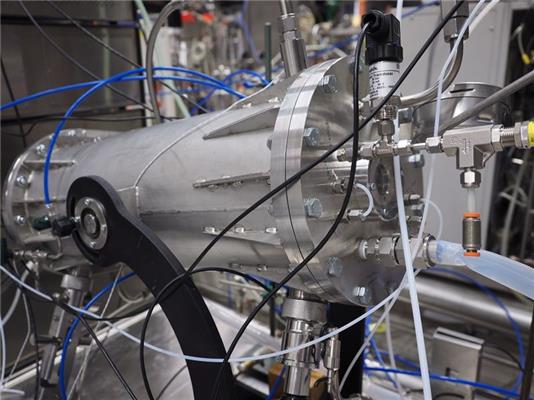
Credit: VTT
The methanotrophic bacteria and (depending on the growth conditions) cell mass may also contain polyhydroxybutyrate plastic (PHB) – a natural substance in the cells that enables them to store conserve energy. For example, PHB can be used as a raw material for biodegradable packaging material, instead of oil-based and non-biodegradable plastics such as polypropylene (PP). The cell mass may contain 50% half of the PHB, in which case the protein content is around 30%. Extraction is used to separate the PHB and protein fractions from the dried cell mass.
Metanotrophic protein biomass

Credit: VTT
The production rate of VTT’s method needs to be improved: a couple of years of development work lies ahead. In addition, the protein fraction’s suitability as a feed component needs to be tested.
Based on previous studies, single-cell proteins produced using micro-organisms can be substituted for ingredients such as meat, soya, egg whites or fish in food and feed. Finland is import-dependent with respect to soya: a fluctuating worldwide crop causes price fluctuations and uncertainty about the availability of this foodstuff.
Metanotrophic bacteria culture
Credit: VTT
In Europe and Finland, attempts are being made to meet the challenge of protein feed for domesticated animals by improving protein self-sufficiency. This mainly involves promoting the production of vegetable protein. The production of single-cell proteins represents a good opportunity to improve our protein self-sufficiency.
Comments Off on Protein Feed And Bioplastic From Farm Biogas, Landfills Or Wastewater
November 27th, 2016
The Daily Journalist.
Scientists behind a theory that the speed of light i,e – and not constant as Einstein suggested – have made a prediction that could be tested.
Einstein observed that the speed of light remains the same in any situation, and this meant that space and time could be different in different situations.
The assumption that the speed of light is constant, and always has been, underpins many theories in physics, such as Einstein’s theory of general relativity. In particular, it plays a role in models of what happened in the very early universe, seconds after the Big Bang.
Credit: Pixabay
But some researchers have suggested that the speed of light could have been much higher in this early universe. Now, one of this theory’s originators, Professor João Magueijo from Imperial College London, working with Dr Niayesh Afshordi at the Perimeter Institute in Canada, has made a prediction that could be used to test the theory’s validity.
Structures in the universe, for example galaxies, all formed from fluctuations in the early universe – tiny differences in density from one region to another. A record of these early fluctuations is imprinted on the cosmic microwave background – a map of the oldest light in the universe – in the form of a ‘spectral index’.
Working with their theory that the fluctuations were influenced by a varying speed of light in the early universe, Professor Magueijo and Dr Afshordi have now used a model to put an exact figure on the spectral index. The predicted figure and the model it is based on are published in the journal Physical Review D.
Cosmologists are currently getting ever more precise readings of this figure, so that prediction could soon be tested – either confirming or ruling out the team’s model of the early universe. Their figure is a very precise 0.96478. This is close to the current estimate of readings of the cosmic microwave background, which puts it around 0.968, with some margin of error.
RADICAL IDEAProfessor Magueijo said: “The theory, which we first proposed in the late-1990s, has now reached a maturity point – it has produced a testable prediction. If observations in the near future do find this number to be accurate, it could lead to a modification of Einstein’s theory of gravity.
“The idea that the speed of light could be variable was radical when first proposed, but with a numerical prediction, it becomes something physicists can actually test. If true, it would mean that the laws of nature were not always the same as they are today.”
The testability of the varying speed of light theory sets it apart from the more mainstream rival theory: inflation. Inflation says that the early universe went through an extremely rapid expansion phase, much faster than the current rate of expansion of the universe.
THE HORIZON PROBLEMThese theories are necessary to overcome what physicists call the ‘horizon problem’. The universe as we see it today appears to be everywhere broadly the same, for example it has a relatively homogenous density.
This could only be true if all regions of the universe were able to influence each other. However, if the speed of light has always been the same, then not enough time has passed for light to have travelled to the edge of the universe, and ‘even out’ the energy.
As an analogy, to heat up a room evenly, the warm air from radiators at either end has to travel across the room and mix fully. The problem for the universe is that the ‘room’ – the observed size of the universe – appears to be too large for this to have happened in the time since it was formed.
The varying speed of light theory suggests that the speed of light was much higher in the early universe, allowing the distant edges to be connected as the universe expanded. The speed of light would have then dropped in a predictable way as the density of the universe changed. This variability led the team to the prediction published today.
The alternative theory is inflation, which attempts to solve this problem by saying that the very early universe evened out while incredibly small, and then suddenly expanded, with the uniformity already imprinted on it. While this means the speed of light and the other laws of physics as we know them are preserved, it requires the invention of an ‘inflation field’ – a set of conditions that only existed at the time.
Comments Off on Is E=MC Squared Wrong?
November 21st, 2016
A University at Buffalo research team has published a paper that implies that the rush to ban and demonize autonomous weapons or “killer robots” may be a temporary solution, but the actual problem is that society is entering into a situation where systems like these have and will become possible. The public needs to better understanding the forces that can lead to development of autonomous weapons and how being a human is at the core of their impact.
Lethal autonomous weapons (LAWs) are a type of military robot designed to select and attack military targets (people, installations) without intervention by a human operator.
A BAE Raven during flight testing

Credit: Wikipedia
Killer robots are at the center of classic stories told in films such as “The Terminator” and the original Star Trek television series’ “The Doomsday Machine,” yet the idea of fully autonomous weapons acting independently of any human agency is not the exclusive license of science fiction writers.
Killer robots have a Pentagon budget line and a group of non-governmental organizations, including Human Rights Watch, is already working collectively to stop their development.Governance and control of systems like killer robots needs to go beyond the end products.
SWORDS Robot: The SWORDS system by Foster Miller allows soldiers to fire small arms weapons by remote control from as far as 1,000 meters away.
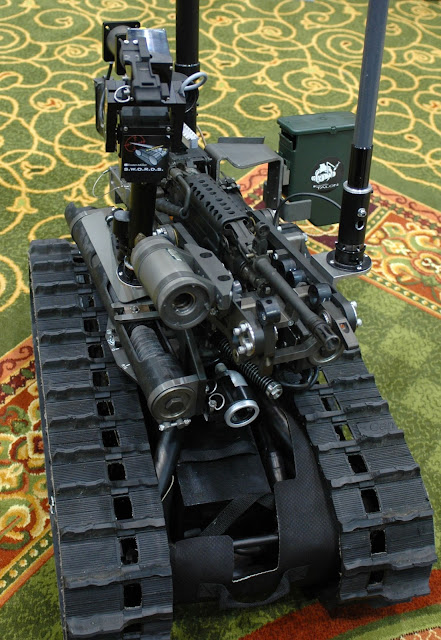
Credit: Wikipedia
“We have to deconstruct the term ‘killer robot’ into smaller cultural techniques,” says Tero Karppi, assistant professor of media study, whose paper with Marc Böhlen, UB professor of media study, and Yvette Granta, a graduate student at the university, appears in the International Journal of Cultural Studies.
“We need to go back and look at the history of machine learning, pattern recognition and predictive modeling, and how these things are conceived,” says Karppi, an expert in critical platform and software studies whose interests include automation, artificial intelligence and how these systems fail. “What are the principles and ideologies of building an automated system? What can it do?”
By looking at killer robots we are forced to address questions that are set to define the coming age of automation, artificial intelligence and robotics, he says.
“Are humans better than robots to make decisions? If not, then what separates humans from robots? When we are defining what robots are and what they do we also define what it means to be a human in this culture and this society,” Karppi says.
Boston Dynamics Atlas Robot
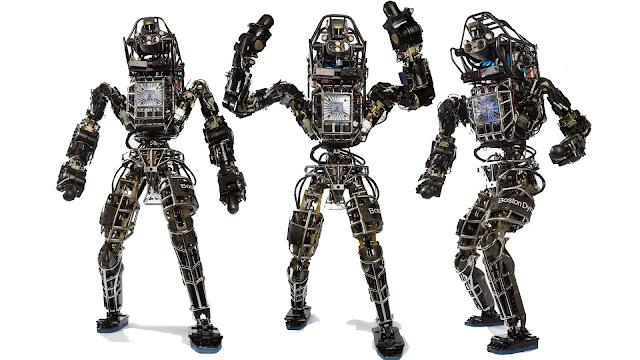
Credit; MIT
Cultural techniques are principles that lead into technical developments. Originally related to agriculture, cultural techniques were once about cultivation and the processes, labors and actions necessary to render land productive and habitable.
In media theory, however, the cultural-techniques approach is interested in various working parts and multiple evolutionary chains of thought, technology, imagination and knowledge production, and how these practices turn into actual systems, products and concepts. Cultural techniques provide insight into the process of becoming: How we got to now.
“Cultural techniques create distinctions in the world,” says Karppi. “Previously humans have had the agency on the battlefield to pull the trigger, but what happens when this agency is given to a robot and because of its complexity we can’t even trace why particular decisions are made in particular situations?”
Any talk of killer robots sounds at first to be an exercise in fantasy, but agencies are already both working to build and trying to prevent the building of their operative foundation.
The Pentagon allocated $18 billion of its latest budget to develop systems and technologies that could form the basis of fully autonomous weapons, instruments that independently seek, identify and attack enemy combatants or targets, according to The New York Times.
A diplomatic strike in this potential theater of machine warfare came in 2012 when a group of NGOs formed “The Campaign to Stop Killer Robots,” charged with banning the development of such weapons.
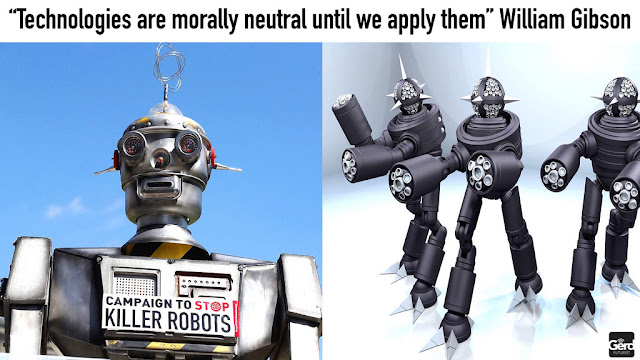 Credit; Gerd Leonhard/Flickr
Credit; Gerd Leonhard/Flickr
But Karppi and his fellow authors argue in their paper “that there is a need to reconsider the composition of the actual threat.”
“Consider how both software and ethical systems operate on certain rules,” says Karppi. “Can we take the ethical rule-based system and code that into the software? Whose ethics do we choose? What does the software allow us to do?”
Self-driving cars operate based on the rules of the road: when to stop, turn, yield or proceed. But autonomous weapons need to distinguish between friend and foe and, perhaps most importantly, when one becomes the other, in the case of surrender, for instance.
“The distinctions between combatant and non-combatant, human and machine, life and death are not drawn by a robot,” write the authors. “While it may be the robot that pulls the trigger, the actual operation of pulling is a consequence of a vast chain of operations, processes and calculations.”
Karppi says it’s necessary to unpack two different elements in the case of killer robots.
“We shouldn’t focus on what is technologically possible,” he says. “But rather the ideological, cultural and political motivations that drive these technological developments.”
Comments Off on Will Banning ‘Killer Robots’ Actually Stop Robots From Killing?
November 21st, 2016
He is best remembered for the magnificent portraits he produced as the court painter of Henry VIII; but a new study of Hans Holbein’s famous ‘Dance Of Death’ suggests that he also had strong anti-establishment views, creating works which foreshadowed modern satire.
As the leading painter at the Court of Henry VIII, Hans Holbein’s magnificent depictions of royalty and nobility affirmed his status as one of the greatest portrait artists of all time. Few would have considered such works the output of a dissident satirist, deeply concerned about the plight of the poor, and committed to religious reform.
But according to a new study of one of his most famous works, The Dance Of Death, satire was not just an area in which Holbein dabbled early in his career, but a central feature of some of his most important work before he came to England.
Holbein’s satirical depictions of authority figures, such as the King in the Dance Of Death (left), are a far cry from later work such as his iconic portrait of Henry VIII (right).

Credit:
Penguin Classics / Wikimedia Commons
Based on new research into the highly-charged climate in which the Dance was produced, the study, by historian Professor Ulinka Rublack, Professor of Early Modern European History and a Fellow of St John’s College, University of Cambridge, argues that it is perhaps the best surviving example of Holbein as a social commentator, using art to mock establishment hypocrisy.
Her portrait of the artist – as an impoverished and angry, but socially and politically engaged, young man – is a far cry from that of the successful painter who produced iconic images of the Tudor ruling class – not least in his famous depiction of a swaggering Henry VIII.
The study forms the commentary to a new Penguin Classics edition of Holbein’s Dance Of Death. It draws on largely unused sources such as local government records from the time at which the Dance was produced. Rublack finds that early in his career, Holbein was part of a group of subversive, passionate artists who were operating in the new medium of print, amid the politically restless atmosphere of Reformation Europe.
“What’s striking is how many of his images in the Dance were about social justice,” Rublack said. “Holbein was part of a movement which was very concerned with radical questions about welfare and reform.”
“Looking at it as satire, rather like a publication such as Charlie Hebdo today, is probably the way to think about what he was doing at the time. Criticising the Pope and Catholic clergy was dangerous stuff; it could be censored and people could be imprisoned for it. But it’s sobering to think nobody was assassinated for it, which has occurred in response to comparable satire in our own time.”
Created between 1524 and 1526, The Dance Of Death was a series of woodcut prints of grisly images apparently demonstrating the folly of human greed and pride. Holbein, who was born in Augsburg, in Germany, produced it while living and working in Basel, in modern-day Switzerland.
Dance of Death, The abbot
Credit: Wikimedia Commons
As a concept, it was the latest in a long line of such series drawing on the medieval idea of the Danse Macabre, in which a recurring cast of stock characters – such as a Pope, an emperor, a king, a monk and a peasant – are individually shown being “taken” by death, represented by grinning, dancing skeletons.
The idea was to challenge the piety of the viewer, by showing death as the great leveller that comes to all. However rich and powerful we may be in this world, the Dance told its viewers, we are all the same in the next and should focus on spiritual concerns.
Although the Dance therefore often poured scorn on those in high society, it was not explicitly satirical beyond this. Holbein’s version has traditionally been seen in those terms – as a religiously-themed genre piece, and not an explicitly political statement.
For the new study, Rublack examined local sources, such as council records, to trace the socio-political context in which Holbein was working. Although the Reformation had not yet arrived in Basel (it would in 1529), she discovered that there was already widespread pressure for reform.
Part of this involved dissatisfaction with the Church and its wealth. The study found accounts of local guilds refusing to supply churches in favour of serving the needs of the poor. One record, from 1524, concerned a baker who, seeing civic dignitaries visiting the grave of a Professor who had opposed religious reform, openly attacked them as “donkey-milking fools”.
More broadly, the Basel commune had begun to stress equal rights against the traditional privileged elites. In 1525, for instance, a group of local villagers marched on Basel, demanding the right to elect their own preachers, and in opposition to feudal taxes.
Holbein, Rublack says, could not have been immune to this. For one thing, he lived among craftspeople, bakers and weavers who had begun to fight for religious and social change. But perhaps more significantly, he himself worked in an “alert” circle of like-minded artists such as the painter and printmaker Urs Graf.
Rublack’s commentary suggests that the life of this group must have resembled that of a satirical, counter-cultural clique. “One can only imagine an atmosphere of creative fun and irreverence, which thrived on jokes against monks, priests, the local bishop and popes,” she writes.
Stylistically, Holbein’s Dance broke established norms by for the first time presenting the genre in printed miniatures, which the viewer would have to peer at to understand. Seen in the context of the politics of the time, Rublack suggests it would have been “a shocking new viewing experience”.
The Pedlar
Credit: Wikimedia Commons
Senior Church figures, including the Pope, were typically shown as overweight and obsessed with luxuries, extorting money in particular by selling indulgences – a cause célèbre of the Reformation. But the Dance also directly critiqued political and judicial leaders for ignoring the plight of the poor – including perhaps the Habsburg Emperor Charles of Spain in the stock “emperor” illustration.
By reworking the traditional Dance formula and adding tokens and signifiers which pointed to political concerns specific to its time, Holbein’s Dance was not just a piece for religious meditation but an early form of political cartoon, designed to delight, surprise and offend.
His reason for shifting from subversive satire to the courtly portraits of his later career can, Rublack suggests, be explained by his financial circumstances. Like most artists in Basel, Holbein struggled to find steady work as a painter – indeed, the study points out that respected contemporaries had been forced to resort to painting fences and carnival decorations.
Rather than carry on illustrating books and working in print, Holbein clearly harboured ambitions to paint – but this could only be realised through the sort of work he eventually obtained at the Tudor Court. Earlier works from England, such as The Ambassadors, pursue similar themes of death, faith and salvation, but working for the likes of Anne Boleyn and Henry VIII broadly put an end to his satirical interests.
Queen Anne Boleyn
Credit: Wikimedia Commons
“What is impressive is that he could have easily made the decision to give up painting, as so many contemporaries did,” Rublack added. “Instead, he made the very risky decision to pursue painting elsewhere. He seems to have known that he had great works like The Ambassadors in him.”
Comments Off on Holbein’s Dance Of Death – The 16th Century Charlie Hebdo
November 21st, 2016
How scientists are using big data analysis to deconstruct the art of storytelling
Our most beloved works of fiction hide well-trodden narratives. And most fictions is based on far fewer storylines than you might have imagined. To come to this conclusion, big data scientists have worked with colleagues from natural language processing to analyse the narrative in more than a thousand works of fiction.
By deconstructing some of the magic of narrative in fiction books, they have also confirmed that there are six different, common ways of telling a story that can be found time and time again in popular stories. They were inspired by the work of US fiction author Kurt Vonnegut, who originally proposed the similarity of emotional story lines in a Masters’s thesis rejected by the University of Chicago. These findings have just been published in EPJ Data Science by Andrew Reagan from the University of Vermont, USA, and colleagues.
Annotated emotional arc of Harry Potter and the Deathly Hallows, by JK Rowling.
Credit: SciencePOD
The authors selected 1,327 books, representative of English works of fiction, from the 50,000 books included in a major open access literature digitisation project called the Gutenberg project. They then applied three different natural language processing filters used for sentiment analysis to extract the emotional content of 10,000-word stories.The first filter—dubbed singular value decomposition—reveals the underlying basis of the emotional storyline, the second—referred to as hierarchical clustering—helps differentiate between different groups of emotional storylines, and the third—which is a type of neural network—uses a self-learning approach to sort the actual storylines from the background noise. Used together, these three approaches provide robust findings, as documented on the hedonometer.org website.
Reagan and colleagues thus determined that there were only six main emotional storylines. These include ‘rags to riches’ (sentiment rises), ‘riches to rags’ (fall), ‘man in a hole’ (fall-rise), ‘icarus’ (rise-fall), ‘Cinderella’ (rise-fall-rise), ‘Oedipus’ (fall-rise-fall). This approach could, in turn, be used to create compelling stories by gaining a better understanding of what has previously made for great storylines. It could also help teach common sense to artificial intelligence systems.
Comments Off on Fictional Books Use Only Six Emotional Story Lines
November 14th, 2016
The Daily Journalist community.

Hillary Clinton’s new e-mail investigation unexpectedly reopened last week eleven days prior to Election Day. She and her campaign staff have openly uttered discontent in how the FBI managed the whole email investigation from day one. She also accuses republican congressmen for their intimidating role to push the FBI to conduct a thorough investigation of her case.
Having access to Wikileaks and read many of the emails I can confirm the following:
– The Clinton Foundation exploits foreign donors in exchange of favors
– She violated protocol as State Secretary for using a private email server to send classified information
– The DNC accepted large sums from big corporations and violated FARA; it created loopholes around the law to receive donations for her campaign that she also used in The Clinton Foundation
– Many bundlers with a significant fraudulent past had a significant direct affiliation with John Podesta, not without Clinton’s consent
– Hillary and Nancy Pelosi received money from Goldman Sachs and other large corporations and in exchange injected TARP –tax payer bailout funds and assets– into the banking system
– The DNC totally outplayed Bernie Sander’s campaign –especially his northern European socialist reforms — and planned his demise from the start of the DNC preliminary election
– John Podesta in multiple occasions invited journalist from the Washington Post, CNN, NBC, ABC, New York Times, Slate and other networks for approval campaign dinners. I have to admit as a journalist that media whoredom inside the DNC was a disappointing surprise, as I once looked with reverence papers like the Washington Post!
– Democracy Partner’s Robert Creamer visited the White House well over one hundred times. He recently was accused of starting campaign violence inside Trump rallies. Thanks to the independent investigative underground report of Project Veritas and not mainstream media, the video exposed a sinister campaign hoopla inside the Clinton campaign hard to ignore
– She turned seven thousand emails, and white washed with bleach another thirty thousand plus messages (the number is precisely unknown); other laptop hard drives and blackberry phones were destroyed using hammers
– Russia, China and other foreign nations have hacked the pentagon in numerous occasions and continue to do so on a regular basis. The DNI states that Russia might be involved with Clinton’s email server hack, but are open to other adversaries. They are also other reports that conclude that Anonymous – the hacking organization responsible of working alongside Julian Assange – is responsible for the hack. In fact, it is likely that Anonymous was responsible for the breach, given that Clinton’s private server was easier to hack compared to the government server – which would take a billion dollar infrastructure to penetrate inside
I am no lawyer on the subject and I won’t pretend to be one today. I don’t know the legalities well enough to propose whether or not Clinton broke the law. These emails at the lowest point present an ‘ethics issue’ that would make anyone seriously question her integrity as a credible politician — not that politicians are ever credible. As the investigation continues to unfold, I am curious to see what other new emails – now under the possession of the FBI– might offer with public disclosure.
Donald Trump has started to rise up on the polls and he is now ahead in many different swing states, including Ohio and Florida. The FBI’s newest investigation might be responsible for the latest Clinton poll flop. I had already forewarned in mid-2015, that the email scandal would eventually creep and inflict a serious blow on Clinton’s campaign. Speculators in the stock market have started to panic and stocks indexes show trade concerns as Trump’s financial reforms are unknown to many investors and lenders nationally and internationally. I am not confident how Trump will tame the financial sector, especially if he wins!
Questions:
1) Do these emails really matter? Or is this all media hype blown out of proportion?
2) Critics point that if Hillary Clinton was not such a powerful politician, but an ordinary civil servant, any other ordinary citizen would be serving time in jail or prison for much less than what she got away on her first FBI investigation? Is this true or untrue?
3) What emails concern you the most? Or are most emails irrelevant?
4) Has the FBI violated federal law for reopening the investigation near election week? Or did the FBI tarnish its reputation after the controversy that surrounded the initial investigation?
5) Is Russia really behind these hacks? Why not China, Iran, Israel or Anonymous to name a few?
6) Given the latest poll results, will the reopening of the FBI investigation grant Trump a presidential victory?

Peter D. Rosenstein.
(He is a non-profit executive, journalist and Democratic and community activist. His background includes teaching; serving as Coordinator of Local Government for the City of New York; working in the Carter Administration; and Vice-chair of the Board of Trustees of the University of the District of Columbia)
“I have just read this sentence you write: Having access to Wikileaks and read many of the emails I can confirm the following:
The fact is you can’t confirm most of what you think you can and you make assumptions in your premise leading up to the questions that is so far off the truth as to be nonsensical.”

Sebastian Sarbu.
(He is a military analyst and vice-president of National Academy of Security and Defense Planning. Member of American Diplomatic Mission for International Relations)
Yes Hillary Clinton is an ordinary civil servant and she must respond transparently to Justice and the American people.
The FBI investigation is a temporary victory of the free press that related some aspects of this story about emails and her scandals.
It is not first case of lack of email transparency, another case regarded former president George W. Bush who related international intelligence with more emails than in Clinton’s case.
But this race regards the ways of such person with her imprudent conduit to lead a country like United States. That is real problem and not how corrupt is that person.
The FBI must continue the investigation independently regarding Hillary’s America. It’s a duty that must prove the independence of justice and the integrity of system. The investigation must check also other possible irregularities of Hillary Clinton.
Russia speculated this political fight. The cyber-security threats is not news, is not something new and in conclusion should not exaggerate or be used in the race for White House by democrats or republicans.”

Paul Pillar.
(He is a Non-resident Senior Fellow at the Center for Security Studies of Georgetown University and the Brookings Institution and an Associate Fellow of the Geneva Center for Security Policy. He retired in 2005 from a 28-year career in the U.S. intelligence community)
“Of course the entire email matter is blown way out of proportion, and never would have become such a huge issue if Republican opponents of Mrs. Clinton had not seized on it as a political stick with which to beat her.
The private server was a stupid move, but the original issue comes down only to the practice of how senior officials who deal with classified information and face enormous demands on their time and their staff’s time–and these are true of any U.S.secretary of state–communicate in ways that enable them to do their jobs efficiently while protecting classified information.
This is a mundane matter of administrative best practices. There is no relationship whatever with ordinary citizens and civil servants who have served time in prison for willfully disclosing classified information to those not authorized to receive it. There is no indication that Mrs. Clinton has ever made such disclosure, that the emails in question have conveyed such information to people without security clearances, or that any classified information in them was ever compromised.
The FBI may not have violated any federal law, but Mr. Comey’s vaguely worded October surprise was a clear violation of Department of Justice policy and deservedly tarnishes his and the FBI’s reputation. This mistake probably will not, however, be enough to swing the election to Trump.”

Claude Forthomme.
(Senior Editor of Impakter Magazine. Passionate traveller (80 countries+) 25 years experience in United Nations: project evaluation specialist; FAO Director for Europe/Central Asia)
“1) These emails do not really matter, they are run-of-the-mill businessfor any politician or businessman (Trump included; why isn’t anyone investigating his business contacts with Russia? Has everyone forgotten that his first campaign manager was directly involved in rehabilitating the Russian-backed party in Ukraine and giving strength to anti-government forces?) Such emails do NOT threaten state security and that’s the point that most people seem to have lost sight of;
2) Ordinary citizens would NOT be spending any time in jail for this sort of thing (and neither should Clinton) – this is populist news-spinning and spreading of unfounded fears; in short, to imply that Clinton ought to spend time in jail for something like this is misleading, almost bizarre: if that were the case, then the USA would suddenly have turned into a totalitarian state, throwing ordinary citizens in jail for their emails!
3) No email concerns me at all. I’m fed up with the whole thing!
4) The FBI has not violated any law for re-opening the investigations, but there was NO NEED to inform Congress since the FBI had in fact NO NEW information to communicate: sending a letter to Congress was equivalent to jumping to conclusions and implying Clinton might be guilty of further “wrongdoings”, though unnamed and unidentified. This, on the part of the FBI, is almost equivalent to slandering a citizen’s reputation (Clinton in this case) and it confirms everybody’s long held suspicion over here in Europe that the FBI is in fact a “state within the state” and that democracy is truly at risk in America.
5) Russia and every other totalitarian state that you mention is behind these and other hacks. Cyber warfare is a staple of 21st century war.
6) The latest polls still show Clinton ahead of Trump but undeniably the FBI’s letter to Congress re-opening the emails investigation has damaged Clinton and most definitely given an advantage to Trump and not only Trump but to all Republicans. Why don’t we list here all the incredible stuff Trump is guilty of as a major con artist and tax evader?”

Dale Yeager.
(He is the CEO of SERAPH and F.L.E.T.C trained Forensic Profiler and U.S. DOJ DOD Federal Law Enforcement SME / Instructor)
“1) Do these emails really matter? Or is this all media hype blown out of proportion?
This is a serious crime affecting the security of the U.S. Yes, these emails matter.
2) Critics point that if Hillary Clinton was not such a powerful politician, but an ordinary civil servant, any other ordinary citizen would be serving time in jail or prison for much less than what she got away on her first FBI investigation? Is this true or untrue?
I have two federals security clearances if I had done this I would have been indicted and in prison.
3) What emails concern you the most? Or are most emails irrelevant?
The mixing of her duties as Secretary of State with donations from foreign governments to her foundation.
4) Has the FBI violated federal law for reopening the investigation near election week? Or did the FBI tarnish its reputation after the controversy that surrounded the initial investigation?
The FBI fixed their first bad action with the current investigation. Either we live by the Rule of Law or we do not.
5) Is Russia really behind these hacks? Why not China, Iran, Israel or Anonymous to name a few?
Who knows. The issue is the manipulation of a U.S. election. But frankly this could have been found by an operative here in the U.S. and leaked to media.
6) Given the latest poll results, will the reopening of the FBI investigation grant Trump a presidential victory?
It’s a toss-up maybe. ”

Nake M. Kamrany.
(He is an eminent Afghan-American development economist with superior experience in economic development who is held in high esteem by the international development community, Afghan leaders, scholars, the private sector and intellectuals. He has more than 20 publications on the political economy of Afghanistan)
“1) Do these emails really matter? Or is this all media hype blown out of proportion?
Yes, these e-mails discovered by FBI do matter as everything in politics matter. YES \the SOURCE MATTERS. I goes to verbosity of the candidates.
2) Critics point that if Hillary Clinton was not such a powerful politician, but an ordinary civil servant, any other ordinary citizen would be serving time in jail or prison for much less than what she got away on her first FBI investigation? Is this true or untrue?
She could lose her security clearance and barred from federal employment and may be fined, I doubt she will serve time in jail.
3) What emails concern you the most? Or are most emails irrelevant?
I do not know, I would have to see the e-mails.
4) Has the FBI violated federal law for reopening the investigation near election week? Or did the FBI tarnish its reputation after the controversy that surrounded the initial investigation?
The FBI was in a bind, no matter what it did it would be criticized by one or the other party.
5) Is Russia really behind these hacks? Why not China, Iran, Israel or Anonymous to name a few?
It should not be significant to Russia or any other country, the ware wasting their resources.
6) Given the latest poll results, will the reopening of the FBI investigation grant Trump a presidential victory?
It may, 2 – 3 points, at this time that might be enough.
Clinton sustained three significant drawback that goes to her verbosity: – fund raising for her trust fund selling influence , violation of e-mail security, and Mr. Clinton granting pardon to a tax evader.”

Ron Aledo.
(He is a retired U.S Army officer, former senior analyst for the CIA (ctr), former senior analyst for the DIA (ctr), operations and intelligence officer for the Joint Staff- The Pentagon, advisor to the Chief of Analysis of the Afghan National Police in Kabul and former International Business Developer for L3 Communications)
“1) Do these emails really matter? Or is this all media hype blown out of proportion?
Absolutely. The FBI needs to see if they are duplicates or new ones. More important they need to see if they contain Classified information or any other ilegal activity. That is the job and duty of the FBI.
2) Critics point that if Hillary Clinton was not such a powerful politician, but an ordinary civil servant, any other ordinary citizen would be serving time in jail or prison for much less than what she got away on her first FBI investigation? Is this true or untrue?
Many people in the US Government has been charged and many others went to jail for a fraction of what Hillary has done. Hillary has the special and illegal protection of Loretta Lynch, high Rank FBI officers and Obama. The US Congress must open an investigation on how Obama and his appointees illegaly used their power to tamper, influence or even block Federal investigations on Hillary, a capital and high crime and a de facto Coup.
3) What emails concern you the most? Or are most emails irrelevant?
Those with classified material.
4) Has the FBI violated federal law for reopening the investigation near election week? Or did the FBI tarnish its reputation after the controversy that surrounded the initial investigation?
The FBI did the right thing as they are Law Enforcement sworn officers. They must be 100% blind to the political calendar. That means, they cannot push forward one day because of politics and they cannot delay one day because of politics. They must move forward as soon as they have new investigative Leads. When they receive leads, they move forward regardless of the election calendar. Politics must not and cannot delay nor speed up Federal Criminal investigations.
5) Is Russia really behind these hacks? Why not China, Iran, Israel or Anonymous to name a few?
The new emails are not the product of Hacks but were discovered in a computer when the FBI was investigating another case (A.W sexual misconduct). As far as WikiLeaks, Assange said recently in an interview that Russia was not the source.
6) Given the latest poll results, will the reopening of the FBI investigation grant Trump a presidential victory?
Nothing is granted. Trump still has a dangerous road to the Presidency. Obama is trying to ilegally block, influence and tamper with the new FBI investigation. Left wing political apointees within DOJ will try to block it. About 90% of the main stream media will keep attacking Trump in desperation and with full rage until the last minute. The Hillary team will bring up more fake ¨sexual assault victims¨until the last minute. So nothing is granted. Many Christians highly concerned with Scalia and soon to retire Thomas seats in the US Supreme Court are praying with devotion just to make reality that Trump victory.”

John Mariotti.
(He as spoken to thousands of people in the business, professional and university audiences in the US and Europe; he hosted a one-hour talk-radio show on the North American Broadcasting Network, (The Life of Business & the Business of Life); founded & moderated, The Reunion Conference, an annual round table/think-tank for 16 years)
“1) Do these emails really matter? Or is this all media hype blown out of proportion?
YES…they matter a lot because they expose illicit and probably illegal activities. They also expose breaches of national security, and a whole series of actions that are explicitly prohibited. Hiding behind “I do not recall” answers does not relieve Hillary Clinton from the other many rules and statutes she violated with her unauthorized and insecure email server. She lied, over and over, during government investigations.
2) Critics point that if Hillary Clinton was not such a powerful politician, but an ordinary civil servant, any other ordinary citizen would be serving time in jail or prison for much less than what she got away on her first FBI investigation? Is this true or untrue?
Absolutely true. There are many examples, including two distinguished generals who were severely penalized. Countless “ordinary Americans” would suffer the full brunt of the law and be convicted, serve time, etc.
3) What emails concern you the most? Or are most emails irrelevant?
Emails between Hillary and president Obama, which makes him complicit in the legal violations; and emails that contain/expose classified information, available to hacking by foreign entities; and emails that illustrate a pattern of behavior that is criminal in nature, subverting the government of the USA; (and hiding emails from the FOIA access—de facto illegal).
4) Has the FBI violated federal law for reopening the investigation near election week? Or did the FBI tarnish its reputation after the controversy that surrounded the initial investigation?
There is NO evidence that the FBI violated any law by reopening an earlier investigation in which it clearly failed to reach the right conclusion. The ability to reopen investigations when new evidence emerges is a central part of the American legal system.
5) Is Russia really behind these hacks? Why not China, Iran, Israel or Anonymous to name a few?
Maybe, but also likely other countries and hackers too. The nature of hacking and the internet makes it difficult to track down and assign blame with much certainty. Government supported/sponsored hacking that started about 20 years ago (from China) continues today. Russian hackers may or may not be government employees, but many of them are supported by, directed by or involved with the Russian government. The Syrian Army hacking organization is also active, likely spreading to ISIS as well.
6) Given the latest poll results, will the reopening of the FBI investigation grant Trump a presidential victory?
Unclear. Trump’s path to the presidency would be a tough one, given the Democrat candidate’s stranglehold on states that add up to 250+/- electoral votes. Trump’s ill-advised behaviors have alienated large voting blocs—notably women, Hispanics, Muslims, etc. He might, as Romney did, lose to a coalition of voting blocs that favor the Democratic candidate. Many of them want to sustain their welfare payments, and continue to borrow, spend, and tax legitimate wage earners to support them (millions who choose to not work—and rely on government largesse for their income).
A Trump win would be a long shot, albeit a “revolution” is needed—A Clinton win will become an American disaster—as she would certainly come into office under FBI and Congressional investigations”

John D. Vernon Sr.
(He has proudly served the United States of America for over 37 years as a Military Officer, retiring at the rank of Colonel,later serving as a Department of Defense civilian, and finally as a Township Supervisor.In 2012, John ran as a Conservative candidate for the U.S. Senate in the Commonwealth of Pennsylvania. He is the CEO, American Warrior Press)
“On November 8, 2016, the American citizens will go to the polls to elect the next President of the United States. The question that will be answered on November 8th is will it be Donald Trump or will it be Hillary Clinton? For many of us, this election cycle is what brings out the worst in people and shows that even a nation such as America can be politically corrupted. The drip drip drip of emails from WikiLeaks, the State Department and the Weiner computer have over shadowed this entire political campaign, regardless of the Donald J. Trumps quips and debate performances. So do Hillary Clinton’s emails matter? In my opinion, only a fool or criminal would say that they do not.
For a large number of Americans, the fact that former Secretary of State Hillary Clinton set up a private “home brew” server in the basement of her home in Chappaqua, New York, to conduct official government business just reeks of dishonesty and corruption.
What we have found out through a series of events, investigations and freedom of information releases from Judicial Watch, is that Hillary Clinton is a very secretive person who did not want the American public to know what she was doing around the world, both as the Secretary of State and as the co-founder of the Clinton foundation, a foundation that took donations from foreign governments like Qatar, Saudi Arabia, Kuwait, UAE, Oman, Brunei, and Algeria to the tune of approximately $60M, paid for her daughter’s wedding, and also provided her daughter with a salary for a decade. Wait a minute, isn’t the foundation a charity?
The American people were shocked when they heard that Hillary Clinton (HRC) had set-up a server in her home to keep her actions private and away from the very people she had taken an oath to work for. In fact, some described this realization of betrayal in term of a personal relationship, where one side or the other had been duped by a series of lies. But it didn’t end there, with just the initial lie at the United Nations building, it has continued for the past year and a half, with lie after lie, building on itself to the point where even the most ardent Clinton supporter was holding their nose.
Not only were people holding their noses after learning of HRC’s secret server, they were putting on their rubber boots in case they stepped in the manure left lying around after they learned that HRC had passed classified material on an unclassified server which was not protected. We now know that slime ball disgraced Congressman Anthony Weiner had access to the same classified material as his wife even though he did not have a need to know, and likely did not have a security clearance. Worse yet, we learned this weekend, that HRC’s maid printed classified messages for HRC and faxed them to unknown locations even though she [the maid] did not have a security clearance; so much for protecting State secrets.
But the American people were yet to get the shock of their lives. In July 2016, FBI Director James Comey announced that HRC had passed over 110 emails containing classified material ranging from confidential to top secret violating a long list of statutes, but he would not recommend indictment because he did not see intent. Director Comey laid out his case methodically even calling HRC reckless, but stopped short of indictment because of, in my opinion, direct involvement from the White House and Department of Justice. At these point, we knew the fix was in, especially after Attorney General Loretta Lynch met with former President and HRC husband Bill Clinton on a remote Arizona airport tarmac days before Comey’s announcement. Did I mention that the Clinton campaign used a computer erasing program called “bleach bit” to permanently delete emails so they could never be recovered even after Congress had given them a preservation order? So much for transparency and honestly with the American people.
It goes without saying that HRC is being treated differently than members of the Armed Forces who have committed lesser security violations. These men and women are currently in prison while HRC was allowed to walk free and run for President of the United States. Without question, HRC status as an elitist has been the catalyst that tipped the scales. I feel so terribly sad for my country.
In my opinion, regardless of who wins the Presidential election tomorrow night, the email issue involving HRC isn’t over. However, according to the Clinton Camp, they blame the Russians for the hack of the Clinton campaign emails even though she was the one who courted the Russians and hit the reset button. Further, I don’t believe that anyone one can trust HRC; she is the female Putin who has exposed State secrets to foreign agents.
So having said all that, since less than 1% of Americans actually have served in the military and only a slightly higher percent have security clearances, most Americans don’t understand the gravity of the HRC missteps and the email issue will not have the effect it should have on the election. However, I believe HRC is nothing short of a criminal and she will not make it through her Presidency should she be elected because she will not be able to curtail her criminal behavior. And if she behaves in this manner, Congress will be waiting to impeach her.
In summary, this Sunday will be a special day for me as I stand with my friends in our place of worship praying for our country. I pray that we can overcome this corruption and that we can make America great again, that we can be inclusive, and that we can end the violence in the world.”

Halyna Mokrushyna.
(Holds a doctorate in linguistics and MA degree in communication. She publishes in Counterpunch, Truthout, and New Cold War on Ukrainian politics, history, and culture. She is also a contributing editor to the New Cold War: Ukraine and beyond and a founder of the Civic group for democracy in Ukraine)
“Tens of thousands of e-mails by Hillary Clinton and by the Chairman of her presidential campaign, John Podesta, are not just media hype. These leaked e-mails are very important because they provide an insight into the inner workings of the American political elite, exposing their hypocrisy and corruption which are eating away the American political system. The US accuses many non-Western governments of precisely the same sin the American politicians indulge in – exchanging money for political influence. Lobbyism is a legalized corruption, and Hillary Clinton is stuck in it up to ears with her Clinton Foundation. The most important e-mails are the ones that disclose Clintons’ intimate relations with the Wall Street making Hillary a mouthpiece of America’s bankers and financiers. Hillary Clinton is a wolf in a sheep skin. Her progressive, liberal rhetoric is no more than that – rhetoric, behind which she hides her service to the profit-greedy American military-industrial and banking complex.
FBI investigations into Hillary Clinton’s violations of the national security will not have a significant effect on the outcome of the presidential election because the most important information was already released by Wiki-leaks.
I am confident it is not Russians who hacked Hillary Clinton’s correspondence. The American obsession with Russians has reached a paranoia level. The virulent Russophobia of Clinton’s campaign is unprecedented in the post-Cold War American political life. The American exceptionalism, in which Hillary Clinton believes blindly and firmly, demands an enemy, and Putin’s Russia fills in that void conveniently. You do not do politics with pure hands. Intelligence services of all countries engage in hacking business, including the US. Ultimately, the most important is not the question who hacked Clinton’s documents. The most important is the content of these documents exposing the money and profit-based political mechanisms behind democratic, progressive rhetoric and an open, confident smile of Hillary Clinton. Her reaction is very revealing: instead of focusing on the content, she skillfully ignores it and diverts the discussion into a not-so-relevant question of who is behind the hacking, hoping to discredit the truth, contained in the hacked correspondence, by the fact that I was scheming, insidious Russians who hacked it.
Russians are not powerful enough to influence the outcome of American presidential election, as Hillary Clinton and her supporters pretend. Russians have a lot to learn from Americans when it comes to building and using soft power abroad to manipulate politics in foreign countries. Julian Assange in his interview to John Pilger clearly stated that Wiki leaks did not obtain all these installments of Clinton’s e-mails from Russians. I have no grounds to doubt his words.
The FBI now closed its investigation into Clinton’s breach of secrecy stating that they will not change their previous decision to not indict her in the absence of proven intent in her actions. It means that for her supports, Clinton is cleared of any accusations. It will not have any impact on Trump supporters because they obtained the proof of Clinton’s corruption in publications by Wiki leaks. I would agree with Assange that Trump will not be allowed to win. The mainstream media on the payroll of the American establishment have been diligently discrediting Trump since the beginning of the electoral campaign. As John Cassidy from the New Yorker writes, Trump, Mr. Make America Great Again, represents nationalist, nativist Americans, hostile toward a self-serving élite that looks down on them. This elite will do whatever it takes to prevent Trump from winning the election. This presidential campaign revealed a deep division inside the American nation, and it is hard to predict which America will win this election – the conservative one or the liberal one.
Trump’s victory would cause a truly tectonic change in corruption-laden American political establishment. The world is tired of American exceptionalism. There is so much to correct and improve within the US political, economic, and social system. American elite should focus on their own backyard instead of teaching others how to live. Donald Trump promised he would do just that.
The call is very close between Donald Trump and Hillary Clinton. Both candidates are very close in public opinion polls, and in any case, the margin of victory will be narrow. I think Trump has slightly better chances of winning than Hillary Clinton. After all, he did surprisingly well in winning the Republican establishment support and becoming a Republican nominee, while many were predicting that this ‘buffoon’ does not have any chance of winning.
We will know soon enough who will be the next president of the greatest superpower in the world.”

Jon Kofas.
(Retired Indiana University university professor academic writing. International political economy — fiction)
“The Political Significance of the ‘Clinton emails’
The email controversy that haunted Hillary Clinton and the Clinton Foundation ‘pay for play scandals’ for a number of years all the way to the end of her bid for president will help to keep the executive branch and central government relatively weak once she is president, assuming she makes it as polls indicate. If Clinton top aides lied to the FBI or if they were involved in what the FBI may deem prosecutable offenses, and if congressional Republicans press this issue, then the new administration will be distracted by such scandals.
On the other hand, if the FBI and/or any Republicans were involved in any type of collusion or conspiracy to secure confidential information from the Clinton campaign, that too may be subject to congressional investigation to determine if there are within the FBI and/or Justice Department rogue elements operating outside legal channels. The FBI investigation into Clinton-related email has exposed the bureau as a highly political agency rather than the image it likes to project.
As published, Wikileak emails simply confirm what had been known about the Clintons and the Democratic National Committee, namely, the level of preponderate influence in the Obama government to make sure that Hillary wins the nomination and the election at any cost, including bending the law to the extent they could do it. The hacked emails reveal the well known connection of the Clintons to Wall Street and the awareness of the various players from John Podesta on down that they were at the very least on the edge of legality but certainly operating a heavy-handed campaign with the considerable muscle of billionaires and millionaires behind them.
The Clinton Foundation charity network does some very good work globally. However, to make money for the key players in the Foundation is typical of how the Clintons operate by merging charity and private political and economic interests. It is clear that the Foundation is somewhat of a front for the family to amass personal wealth. People who had looked into the considerable wealth that the Clintons amassed in the last fifteen years did not need Wikileaks to tell them that the family had cleverly merged charity with private interests as a means of becoming multimillionaires.
The Clintons have a well known record as pro-Wall Street politicians while at the same time trying to appeal to the Democratic Party’s working class and middle class base that has been hurt by neoliberal policies they have been supporting since the 1990s. Once in office, she will continue the same neoliberal policies with a firm commitment to strengthening defense and continuing militaristic solutions to political crises around the world. This does not mean that there would be no proposals for development of the infrastructure, reforming the college debt mess currently at $1.3 trillion, refining health care reform including come controls on drug prices, as well as other social programs. As president, Clinton would support a more humane position on immigration, law and order regime that currently target minorities, gender equality, and socio-cultural tolerance. To the extent that congressional Republicans go along, some of these measures will pass.
In a pluralistic society, these are all important but they will have only a marginal impact on living standards that will continue to decline for the working class and the middle class in the next four years. Minimum wage will most definitely go up largely because corporations are raising it. For example, WALMART adopted the wage model of COSTCO and discovered that its sales and productivity rose as a result of raising wages. Along with state-mandated minimum wage laws, corporations will likely continue raising wages even if the federal minimum wage is raised at a slow pace in the next five years as expected. Although a higher minimum wage is imperative as living standards have risen and the US rests so inordinately on consumer spending, the occupant of the White House will take credit for supporting the policy.
Politicians above the Law
Political corruption in the US is not anywhere near many other countries where heads of state enter politics poor and in the process become millionaires or even billionaires. There are strict laws about political corruption, but at the same time the laws provide many windows of opportunity to politicians to profit once they exit from public life while they become peddlers for corporate America as influence peddlers on policy. Public corruption is invariably linked to private sector corruption, although rarely does the media point any fingers at the private sector, focusing instead on the public officials at the receiving end.
Just as big banks and big corporations are too big to fail, so are ‘big politicians’ like Hillary Clinton. Presidents have been impeached, and others removed from office; senators and congressmen stripped of their seats, and governors have served in minimum security facilities. All of them for crimes carried out with the goal of illegally amassing personal wealth, obstruction of justice or some other activity to the detriment of their office. As long as the politician follows the legal path which is very wide and open, it is assumed if not expected that she/he will be rewarded by the system and at some point while protected legally in the process.
Senator Bernie Sanders was right that the Clinton State Department emails controversy as relating to Libya was simply red meat for Republicans; the real crime was her close ties to billionaires and Wall Street. Because of Wikileaks, the world now knows that John Podesta’s multi-million dollar consulting-lobbying firm in Washington works closely with billionaires who define the issues and control the Democratic Party. One could argue that even if Wikileaks had not revealed this hacked email the world already knew enough to reach the exact same conclusion. Besides, aren’t billionaires also behind the Republican Party and out in the open about it? Most people are resigned to this reality and are unlikely to react with much surprise or hostility that Hillary Clinton and powerful politicians are above the law or at least the privileged class treated by a different set of criteria than the average person.
Russia, Wikileaks and Political Distraction
I have no way of knowing if Russia is behind the stolen email controversy and I honestly do not believe it matters. The accusers have never provided evidence to prove their claims and if they ever do, the evidence would have to be carefully scrutinized for authenticity. There are several issues here. First, if Russia is indeed behind Wikileaks, is it because it desperately wanted Trump to win. One would have to assume that the Kremlin knew such interference exposed would in reality help Clinton not Trump. Although Putin has said that he will work with anyone in the White House, he probably preferred authoritarian Trump who would not have continued the military solution option in Syria and would not have pressed as much as Clinton on the issue of sanctions and containment that Obama has been pursuing.
Putin is correct that it is absurd to assume Russia can influence the US election even if it tried. On the contrary, American voters make up their minds on the basis of what goes on inside the country, relying on their historic ties to a political party and how they perceive the candidates would best serve their ideological, socioeconomic and cultural interests. More often than not, the perceived interests and aspirations of voters are based on illusions rather than anything real. An unemployed coal miner in West Virginia parading the confederate flag on the backside of his pickup truck displaying Trump bumper stickers has placed his fate on a 70-year old billionaire playboy who has benefited from corporate welfare and hardly paid any federal income taxes in his life. In their most sinister schemes the people in the Kremlin could not possibly come up with anything to persuade people like this unemployed coal miner to vote one way or another.
Let us assume that Russia is indeed behind the stolen emails, although they and Julian Assange have denied it. If Moscow is indeed behind all of it, does this absolve the corruption within the Clinton campaign that was wide and deep? Considering that public opinion polls indicate that Hillary Clinton is less trustworthy than Trump, does the public need Moscow to reveal more about the Clintons than people already know for the last three decades? If more people consider Clinton less trustworthy than a man who by any criteria is a neo-Fascist, what does this tell us about the candidate who orchestrated her way to the presidential nomination by manipulating the democratic process, with the media’s voluntary support to crush her opponent Bernie Sanders?
Concealing her candidacy behind so many veils of deception to secure the vote has indeed worked no matter what Wikileaks reveals, largely because the corporate media representing Wall Street wanted to advance her candidacy just as it advanced that of Trump in the primary season. The typical Cold War prism of looking to the evil Russian empire to blame for homegrown problems has its limits. Propaganda is the essence of politics but it also backfires when one cries wolf one too many times and there is no wolf to be found.”
Comments Off on Do Hillary Clinton’s Emails Matter?
November 14th, 2016
The Daily Journalist.
Archeologists from the University of Tübingen perform excavation work just 45 kilometers from IS territory – the settlement may have been an outpost of the Akkadian Empire.
Archeologists from the Institute for Ancient Near Eastern Studies (IANES) at the University of Tübingen have uncovered a large Bronze Age city not far from the town of Dohuk in northern Iraq. The excavation work has demonstrated that the settlement, which is now home to the small Kurdish village of Bassetki in the Autonomous Region of Kurdistan, was established in about 3000 BC and was able to flourish for more than 1200 years.
The mound of ruins at Bassetki with the broad area of the lower town where sheep now graze.
Photo: P. Pfälzner
The archeologists also discovered settlement layers dating from the Akkadian Empire period (2340-2200 BC), which is regarded as the first world empire in human history.
Scientists headed by Professor Peter Pfälzner from the University of Tübingen and Dr. Hasan Qasim from the Directorate of Antiquities in Dohuk conducted the excavation work in Bassetki between August and October 2016. As a result, they were able to preempt the construction work on a highway on this land. The former significance of the settlement can be seen from the finds discovered during the excavation work.
Map of the Akkadian Empire (brown) and the directions in which military campaigns were conducted (yellow arrows) It also shows approximate extension of the Akkad empire during the reign of Narâm-Sîn (2254-2218 B.C.
Credit: Wikipedia
The city already had a wall running around the upper part of the town from approx. 2700 BC onwards in order to protect its residents from invaders. Large stone structures were erected there in about 1800 BC. The researchers also found fragments of Assyrian cuneiform tablets dating from about 1300 BC, which suggested the existence of a temple dedicated to the Mesopotamian weather god Adad on this site. There was a lower town about one kilometer long outside the city center.
Using geomagnetic resistance measurements, the archeologists discovered indications of an extensive road network, various residential districts, grand houses and a kind of palatial building dating from the Bronze Age. The residents buried their dead at a cemetery outside the city. The settlement was connected to the neighboring regions of Mesopotamia and Anatolia via an overland roadway dating from about 1800 BC.
Bassetki was only known to the general public in the past because of the “Bassetki statue,” which was discovered there by chance in 1975. This is a fragment of a bronze figure of the Akkadian god-king Naram-Sin (about 2250 BC).
Excavating the eastern slope of the upper part of Bassetki, where several fragments of Assyrian cuneiform tablets were discovered.
Photo: P. Pfälzner
The discovery was stolen from the National Museum in Baghdad during the Iraq War in 2003, but was later rediscovered by US soldiers. Up until now, researchers were unable to explain the location of the find. The archeologists have now been able to substantiate their assumption that an important outpost of Akkadian culture may have been located there.
Although the excavation site is only 45 kilometers from territory controlled by the IS, it was possible to conduct the archeological work without any disturbances. “The protection of our employees is always our top priority. Despite the geographical proximity to IS, there’s a great deal of security and stability in the Kurdish autonomous areas in Iraq,” said Professor Peter Pfälzner, Director of the Department of Near Eastern Archaeology at the IANES of the University of Tübingen. The research team consisting of 30 people lived in the city of Dohuk, which is only 60 kilometers north of Mosul, during the excavation work.
Excavating down to the Bronze Age layers in the upper part of Bassetki.
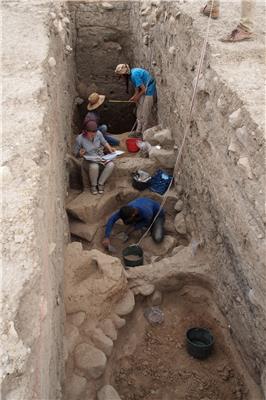
Photo: P. Pfälzner
In another project being handled by the “ResourceCultures” collaborative research center (SFB 1070), Pfälzner’s team has been completing an archeological inspection of territory in the complete area surrounding Bassetki as far as the Turkish and Syrian borders since 2013 – and 300 previously unknown sites have been discovered. The excavations and the research work in the region are due to be continued during the summer of 2017.
“The area around Bassetki is proving to be an unexpectedly rich cultural region, which was located at the crossroads of communication ways between the Mesopotamian, Syrian and Anatolian cultures during the Bronze Age. We’re therefore planning to establish a long-term archeological research project in the region in conjunction with our Kurdish colleagues,” says Pfälzner. The excavation work is being funded by the Fritz Thyssen Foundation.
Comments Off on Significant Bronze Age City Discovered In Northern Iraq
November 14th, 2016
The Daily Journalist.
It has been known for some time that the extracts of the Cannabis plant, just like synthetic cannabinoids and those produced by the brain itself, join up with type 1 (CB1) cannabinoid receptors located in the nerve endings of the neurons, and inhibit the release of chemical messengers (neurotransmitters) in the communication areas between the nerve cells.
The knowledge about the way cannabinoids work has been expanded in recent years when it was shown that the CB1 receptor is also located in and functions in the mitochondria of the neurons; mitochondria are the organelles responsible for producing cell energy.
The bracts surrounding a cluster of Cannabis sativa flowers are coated with cannabinoid-laden trichomes

A new piece of research, which has been published in the online version of the journal Nature, has now gone a step further on discovering that the amnesia caused by cannabinoids needs the activation of the CB1 cannabinoid receptors located in the mitochondria of the hippocampus, the brain structure involved in memory formation.
To obtain the results of this research, led by Dr Giovanni Marsicano of the University of Bordeaux, the contribution of the following doctors was crucial: Nagore Puente, Leire Reguero, Izaskun Elezgarai and Pedro Grandes; they are neuro-scientists in the Department of Neurosciences of the UPV/EHU’s Faculty of Medicine and Nursing and of the Achucarro Basque Center for Neuroscience and they also participated in a previous discovery about the location and functioning of the CB1 receptor in the mitochondria. In this new piece of research, the researchers used a broad range of cutting-edge experimental techniques and saw that the genetic elimination of the CB1 receptor from the mitochondria of the hippo-campus prevents memory loss, the reduction in mitochondrial movement and the decrease in neural communication induced by the cannabinoids.
This research also revealed that the amnesia caused by cannabinoids and the related cell processes are linked to an acute alteration in bioenergetic mitochondrial activity owing to the direct activation of the CB1 receptors in the mitrochondria. This activation leads to the inhibiting of the cannabinoid signalling cascade inside the mitochondria and cell respiration diminishes as a result. This reduction in cell respiration through cannabinoids is not restricted to the brain as a similar phenomenon occurs in skeletal and cardiac muscle, as has recently been published in another piece of research by the group of Dr Grandes.
“Mitochondrial malfunctioning could have serious consequences for the brain. For example, chronic mitochondrial dysfunction is involved in the pathogenesis of neuro-degenerative diseases, strokes or disorders associated with ageing. However, the involvement of the acute variation in mitochondrial activity in higher brain functions, such as memory, was unknown,” pointed out Dr Grandes. So this research has revealed that the CB1 cannabinoid receptors in the mitochondria regulate the memory processes by modulating mitochondrial energy metabolism.
Pedro Grandes, Izaskun Elezgarai, Leire Reguero and Nagore Puente
Credit: University of The Basque Country
Furthermore, although cannabinoid by-products have a well-known therapeutic potential, their use is limited by the significant adverse effects that emerge when acting on CB1 receptors, including memory loss. The results of this research suggest that “a selective intervention on specific CB1 cannabinoid receptors located in the brain in certain specific neurone compartments could be of interest with a view to developing new therapeutic tools based on the most effective and safest cannabinoids in the treatment of certain brain diseases,” explained Dr Grandes.
“This research is the result of 6 years’ work in which 28 researchers have participated. In our case it would not have been possible without the funding received from the UPV/EHU, the Basque Government and Spanish institutions, which have placed their trust in us even during these years of tremendous cutbacks for research; this is something I recognise and which I am grateful for,” concluded Pedro Grandes.
Pedro Grandes has recently been Visiting Professor at the University of Victoria, British Columbia, University of The Basque Countryanada, where he has been doing research work and teaching students of medicine and post-graduate students.
Comments Off on How Cannabis Affects Memory
November 11th, 2016
Compact refineries may one day produce a variety of vehicle fuels as well as chemicals from air, water and sunlight.
The Lappeenranta University of Technology (LUT) and VTT Technical Research Centre of Finland are building a unique demo plant that will pilot the production of renewable fuels with solar power. The sun, water and carbon dioxide extracted from air will act as the raw materials for power.
The production plant made up of container-sized units assembled on the LUT campus will be completed in 2017. The purpose of this cooperative project is to convert solar power-produced electricity into gas or liquid fuels.
Production of synthetic fuels from solar energy and carbon dioxide extracted from air is the objective of the SOLETAIR project started now by INERATEC, a spinoff of Karlsruhe Institute of Technology (KIT), in cooperation with the Finnish partners. The three partners plan to build the world’s first operational compact chemical plant.. The pilot plant is so compact that it fits into a ship container and produces gasoline, diesel, and kerosene from regenerative hydrogen and carbon dioxide.
Credit: KIT
The plant consists of three components. The direct air capture unit developed by the Technical Research Center of Finland (VTT) extracts carbon dioxide from air. An electrolysis unit developed by Lappeenranta University of Technology (LUT) produces the required hydrogen by means of solar power. A microstructured, chemical reactor is the key component of the plant and converts the hydrogen produced from solar power together with carbon dioxide into liquid fuels. This reactor was developed by KIT. The compact plant was developed to maturity and is now being commercialized by INERATEC.“Projects, such as SOLETAIR, are essential for the success of the energy turnaround,” Professor Thomas Hirth, Vice President for Innovation and International Affairs of KIT, says. “Commissioning of this pilot plant is an example of successful transfer of KIT’s research innovations to industry.” INERATEC GmbH is a spinoff of KIT and develops, constructs, and sells compact chemical plants for various gas-to-liquid and power-to-liquid applications. The spinoff is supported under the EXIST research transfer program of the Federal Ministry for Economic Affairs and Energy.
INERATEC’s microstructured chemical reactor can convert methane-containing gases into liquid synthetic fuels of highest quality.
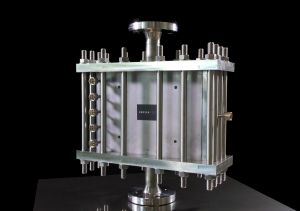
Photo: INERATEC/KIT
“We are proud of our participation in this promising international project,” INERATEC founder Dr. Tim Böltken emphasizes. In the future, KIT, INERATEC, and VTT plan to extend their cooperation. Under the national research alliances of “Energy Lab 2.0” and “Neo-Carbon Energy,” work will focus on the investigation and development of innovative energy systems based on renewable energy sources, novel storage technologies, and the conversion of renewable energies into chemical energy carriers. In addition, KIT and INERATEC contribute their expertise to the “Power-to-X” Kopernikus project funded by the Federal Ministry of Education and Research.
“The energy project will only be a success, if we pool our know-how and jointly strengthen the competencies of European industry in the energy sector,” VTT scientist and SOLETAIR project head Dr. Pekka Simell says with respect to the planned cooperation. The new power-to-liquid plant will be taken into operation at the BIORUUKKI Piloting Center of VTT this year. In 2017, operation is planned to be continued on the campus of LUT. The SOLETAIR project will be completed in mid-2018. It is funded with EUR 1 million by the Finnish Funding Agency for Technology and Innovation (Tekes).
The plant will be used to demonstrate how processes can be combined in a way that allows the use of renewable electricity in the production of methane, fuels and chemicals. The demo plant could also function as a fueling station for vehicles that run on hydrogen or natural gas.
“This research is the first of its kind in Finland in this type of combination of processes,” states LUT Professor Jero Ahola, who is responsible for the research.
“The project will produce expertise for enterprises in various fields, and it will result in a multidisciplinary industrial integration that no one company can achieve on its own. Collaboration will strengthen the expertise of Finnish industry in this sector,” states VTT’s Principal Scientist Pekka Simell. He is responsible for coordinating the project as well as VTT’s share of the research.
To help cut carbon dioxide emissions, in the future, all sectors of industry must be within the scope of carbon dioxide emission-free energy production. In practice, this means that the future’s most important energy market will be the electricity market, where different sectors of industry will operate with electricity produced from carbon dioxide emission-free energy sources. Combining the electricity system and other energy systems will be successful with the researched methods.
Comments Off on Refinery In A Container Produces Liquid Fuels From Air, Water And Sunlight
November 10th, 2016
Men who have worked night shifts for more than 20 years, or who work night shifts without daytime napping, or sleep for more than ten hours per night on average may have an increased risk of cancer, according to a study published in Annals of Medicine.
The study, led by scientists based at the Huazhong University of Science and Technology, Wuhan, China, reviewed data obtained via interviews with middle-aged and older Chinese in the Dongfeng-Tongji Cohort Study, a cohort of approximately 27,000 retired workers from the Dongfeng Motor Corporation.

The researchers sought to investigate the independent and combined effects of three sleep habits on cancer incidence; night shift work, daytime napping, and night time sleep. Via a questionnaire they ascertained individuals who had worked night shifts for over 20 years, had a habit of taking day time naps, and when they usually went to sleep at night and woke up in the morning.
The authors report that men who had worked night shifts for over 20 years had a 27% increased risk of cancer incidence, and that men that did not nap in the day time had double the risk of cancer of those who took a 1 to 30-minute nap. They also found that men who slept for more than ten hours per night had an increased risk of cancer. However, no such relationship was observed in women.
The researchers also found that male participants with at least two of these sleep habits (long-term night shift work, lack of daytime napping, or sleeping over ten hours per night) had a 43% increased risk of cancer incidence and a two-fold increase in cancer mortality compared to those who exhibited none of the sleep habits.
The authors recognise that their conclusions may be limited by the self-reported lifestyle data, the ageing nature of the cohort and a relatively short-term follow-up period. They recommend that a longer term study should follow up this initial study to verify their findings.
Comments Off on Male Sleep Habits May Increase Cancer Risk
November 2nd, 2016
The Daily Journalist.
A new study shows why pollution results in larger, deeper and longer lasting storm clouds, leading to colder days and warmer nights
A new study reveals how pollution causes thunderstorms to leave behind larger, deeper, longer lasting clouds. Appearing in the Proceedings of the National Academy of Sciences November 26, the results solve a long-standing debate and reveal how pollution plays into climate warming. The work can also provide a gauge for the accuracy of weather and climate models.
Researchers had thought that pollution causes larger and longer-lasting storm clouds by making thunderheads draftier through a process known as convection. But atmospheric scientist Jiwen Fan and her colleagues show that pollution instead makes clouds linger by decreasing the size and increasing the lifespan of cloud and ice particles. The difference affects how scientists represent clouds in climate models.
“This study reconciles what we see in real life to what computer models show us,” said Fan of the Department of Energy’s Pacific Northwest National Laboratory. “Observations consistently show taller and bigger anvil-shaped clouds in storm systems with pollution, but the models don’t always show stronger convection. Now we know why.”
Also, pollution can decrease the daily temperature range via such clouds: High clouds left after a thunderstorm spread out across the sky and look like anvils. These clouds cool the earth during the day with their shadows but trap heat like a blanket at night. Pollution can cause clouds from late afternoon thunderstorms to last long into the night rather than dissipate, causing warmer nights.
Secret Life of Clouds
Models that predict weather and climate don’t reconstruct the lives of clouds well, especially storm clouds. Usually these models replace storm clouds with simple equations that fail to capture the whole picture.
Because of the poor reconstructions, researchers have been faced with a dilemma: Pollution causes the anvil-shaped clouds to linger longer than they would in clean skies — but why?
Possible reasons revolve around tiny natural and manmade particles called aerosols that serve as seeds for cloud droplets to form around. A polluted sky has many more aerosols than a clean sky — think haze and smog — and that means less water for each seed. Pollution makes more cloud droplets, but each droplet is smaller.
More and smaller droplets change things for the clouds. Researchers have long thought that smaller droplets start a chain reaction that leads to bigger, longer-lasting clouds: Instead of raining down, the lighter droplets carry their water higher, where they freeze. The freezing squeezes out the heat the droplets carry with them and causes the thunder cloud to become draftier. The stronger convection lifts more water droplets, building up the cloud.
But researchers don’t always see stronger convection every time they see larger and longer-lasting clouds in polluted environments, indicating a piece of the puzzle was missing.
To solve this dilemma, Fan and colleagues decided to compare real-life summer storm clouds to a computer model that zooms deep into simulated clouds. The model included physical properties of the cloud particles as well as the ability to see convection, if it gets stronger or weaker. Most models run in days or weeks, but the simulations in this study took up to six months.
“Modeling the details of cloud microphysical properties is very computationally intensive, so models don’t usually include them,” said Fan.
Convection Vexation
The researchers started with cloud data from three locations that differ in how polluted, humid and windy they typically are: the tropics in the western Pacific, southeastern China and the Great Plains in Oklahoma. The data had been collected through DOE’s ARM Climate Research Facility.
With support from DOE’s Regional and Global Climate Model program, the research ran simulations on PNNL’s hometown supercomputer Olympus. Their simulations of a month of storms ended up looking very similar to the actual observed clouds, validating that the models re-created the storm clouds well.
The team found that in all cases, pollution increased the size, thickness and duration of the anvil-shaped clouds. However, only two locations — the tropics and China — showed stronger convection. The opposite happened in Oklahoma — pollution made for weaker convection.
This inconsistency suggested that stronger convection isn’t the reason. Taking a closer look at the properties of water droplets and ice crystals within clouds, the team found that pollution resulted in smaller droplets and ice crystals, regardless of location.
In addition, the team found that in clean skies, the heavier ice particles fall faster out of the anvil-shaped clouds, causing the clouds to dissipate. However, the ice crystals in polluted skies were smaller and too light to fall out of the clouds, leading to the larger, longer-lasting clouds.
Lastly, the team estimated how much warming or cooling the storm clouds contributed. Overall, the polluted clouds cooled the day and warmed the night, decreasing the daily temperature range.
Pollution decreases the size of cloud and ice particles and increases their lifespans, making clouds grow bigger.
Credit: PNNL
Most models don’t simulate convection well, take into account the microphysical processes of storm clouds, nor address how pollution interacts with those processes. Accounting for pollution effects on storm clouds in this way could affect the ultimate amount of warming predicted for the earth in the next few decades. Accurately representing clouds in climate models is key to improving the accuracy of predicted changes to the climate.
This work was supported by the DOE’s Office of Science.
Comments Off on Pollution Makes Storms Last Longer, Days Colder And Nights Warmer
November 2nd, 2016
The Daily Journalist.
Spinach is no longer just a superfood: By embedding leaves with carbon nanotubes, MIT engineers have transformed spinach plants into sensors that can detect explosives and wirelessly relay that information to a handheld device similar to a smartphone.
This is one of the first demonstrations of engineering electronic systems into plants, an approach that the researchers call “plant nanobionics.”
“The goal of plant nanobionics is to introduce nanoparticles into the plant to give it non-native functions,” says Michael Strano, the Carbon P. Dubbs Professor of Chemical Engineering at MIT and the leader of the research team
By embedding spinach leaves with carbon nanotubes, MIT engineers have transformed spinach plants into sensors that can detect explosives and wirelessly relay that information to a handheld device similar to a smartphone.

Illustration: Christine Daniloff/MIT
In this case, the plants were designed to detect chemical compounds known as nitroaromatics, which are often used in landmines and other explosives. When one of these chemicals is present in the groundwater sampled naturally by the plant, carbon nanotubes embedded in the plant leaves emit a fluorescent signal that can be read with an infrared camera. The camera can be attached to a small computer similar to a smartphone, which then sends an email to the user.
“This is a novel demonstration of how we have overcome the plant/human communication barrier,” says Strano, who believes plant power could also be harnessed to warn of pollutants and environmental conditions such as drought.
Credit; MIT
Strano is the senior author of a paper describing the nanobionic plants in the Oct. 31 issue of Nature Materials. The paper’s lead authors are Min Hao Wong, an MIT graduate student who has started a company called Plantea to further develop this technology, and Juan Pablo Giraldo, a former MIT postdoc who is now an assistant professor at the University of California at Riverside.
Environmental monitoring
Two years ago, in the first demonstration of plant nanobionics, Strano and Giraldo used nanoparticles to enhance plants’ photosynthesis ability and to turn them into sensors for nitric oxide, a pollutant produced by combustion.
Plants are ideally suited for monitoring the environment because they already take in a lot of information from their surroundings, Strano says.
“Plants are very good analytical chemists,” he says. “They have an extensive root network in the soil, are constantly sampling groundwater, and have a way to self-power the transport of that water up into the leaves.”
Strano’s lab has previously developed carbon nanotubes that can be used as sensors to detect a wide range of molecules, including hydrogen peroxide, the explosive TNT, and the nerve gas sarin. When the target molecule binds to a polymer wrapped around the nanotube, it alters the tube’s fluorescence.
In the new study, the researchers embedded sensors for nitroaromatic compounds into the leaves of spinach plants. Using a technique called vascular infusion, which involves applying a solution of nanoparticles to the underside of the leaf, they placed the sensors into a leaf layer known as the mesophyll, which is where most photosynthesis takes place.
They also embedded carbon nanotubes that emit a constant fluorescent signal that serves as a reference. This allows the researchers to compare the two fluorescent signals, making it easier to determine if the explosive sensor has detected anything. If there are any explosive molecules in the groundwater, it takes about 10 minutes for the plant to draw them up into the leaves, where they encounter the detector.
To read the signal, the researchers shine a laser onto the leaf, prompting the nanotubes in the leaf to emit near-infrared fluorescent light. This can be detected with a small infrared camera connected to a Raspberry Pi, a $35 credit-card-sized computer similar to the computer inside a smartphone. The signal could also be detected with a smartphone by removing the infrared filter that most camera phones have, the researchers say.
“This setup could be replaced by a cell phone and the right kind of camera,” Strano says. “It’s just the infrared filter that would stop you from using your cell phone.”
Using this setup, the researchers can pick up a signal from about 1 meter away from the plant, and they are now working on increasing that distance.
Michael McAlpine, an associate professor of mechanical engineering at the University of Minnesota, says this approach holds great potential for engineering not only sensors but many other kinds of bionic plants that might receive radio signals or change color.
“When you have manmade materials infiltrated into a living organism, you can have plants do things that plants don’t ordinarily do,” says McAlpine, who was not involved in the research. “Once you start to think of living organisms like plants as biomaterials that can be combined with electronic materials, this is all possible.”
“A wealth of information”
In the 2014 plant nanobionics study, Strano’s lab worked with a common laboratory plant known as Arabidopsis thaliana. However, the researchers wanted to use common spinach plants for the latest study, to demonstrate the versatility of this technique. “You can apply these techniques with any living plant,” Strano says.
So far, the researchers have also engineered spinach plants that can detect dopamine, which influences plant root growth, and they are now working on additional sensors, including some that track the chemicals plants use to convey information within their own tissues.
“Plants are very environmentally responsive,” Strano says. “They know that there is going to be a drought long before we do. They can detect small changes in the properties of soil and water potential. If we tap into those chemical signaling pathways, there is a wealth of information to access.”
These sensors could also help botanists learn more about the inner workings of plants, monitor plant health, and maximize the yield of rare compounds synthesized by plants such as the Madagascar periwinkle, which produces drugs used to treat cancer.
“These sensors give real-time information from the plant. It is almost like having the plant talk to us about the environment they are in,” Wong says. “In the case of precision agriculture, having such information can directly affect yield and margins.”
Comments Off on Nanobionic Spinach Plants Detect Explosives, Communicate With Humans Wireless









